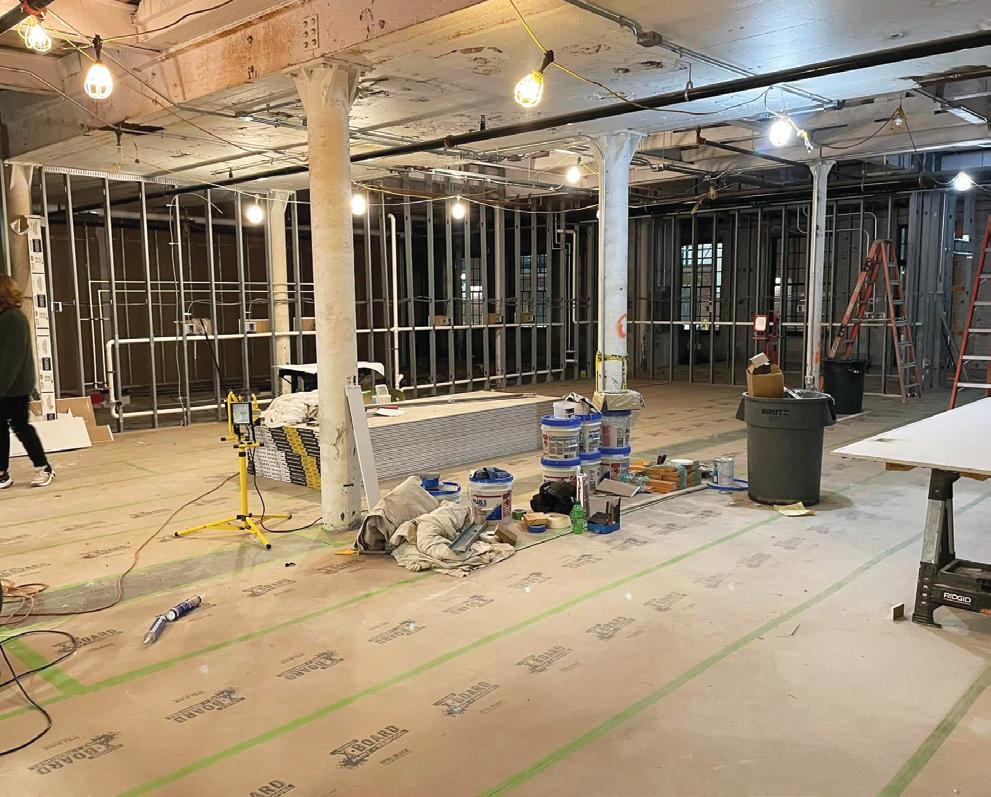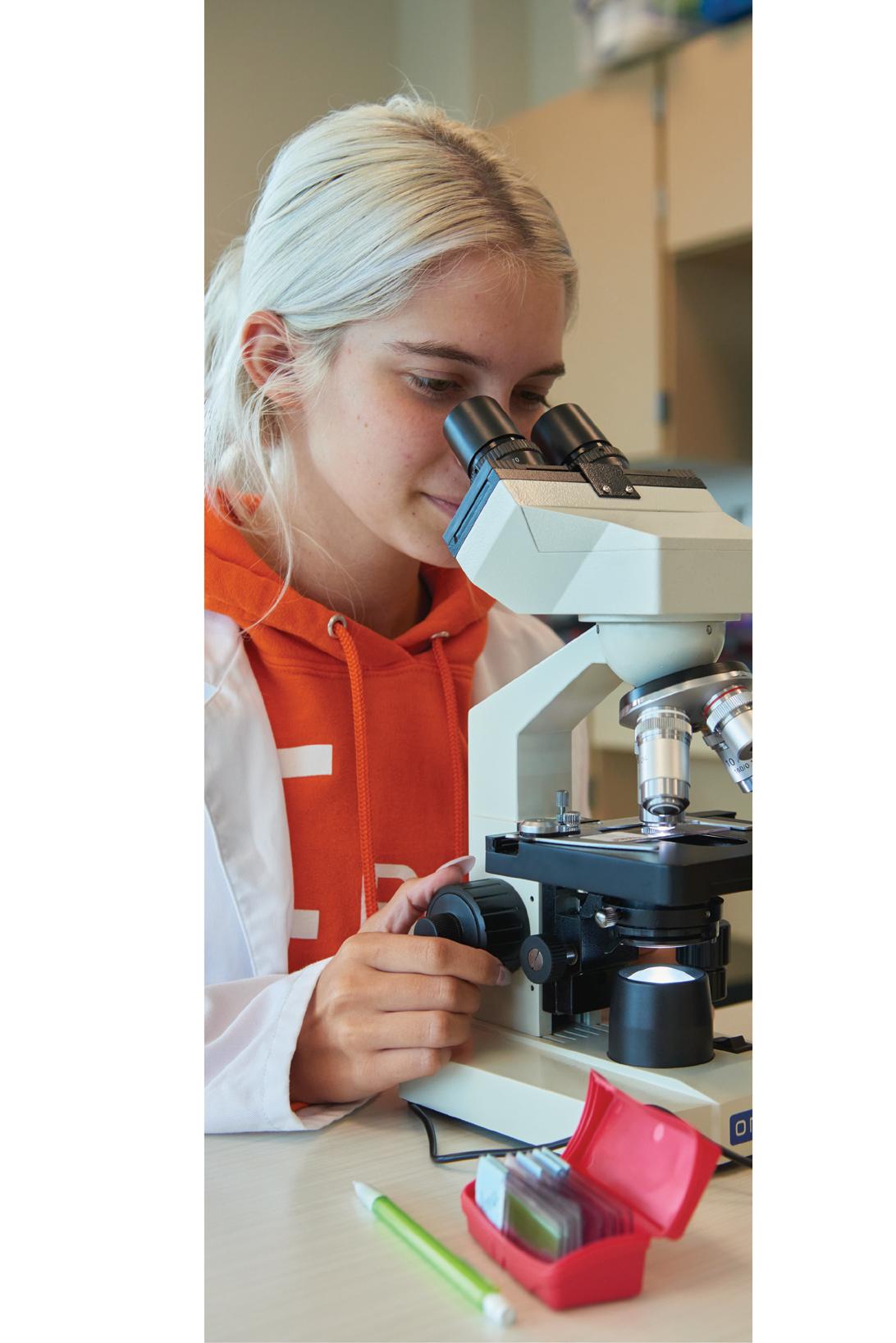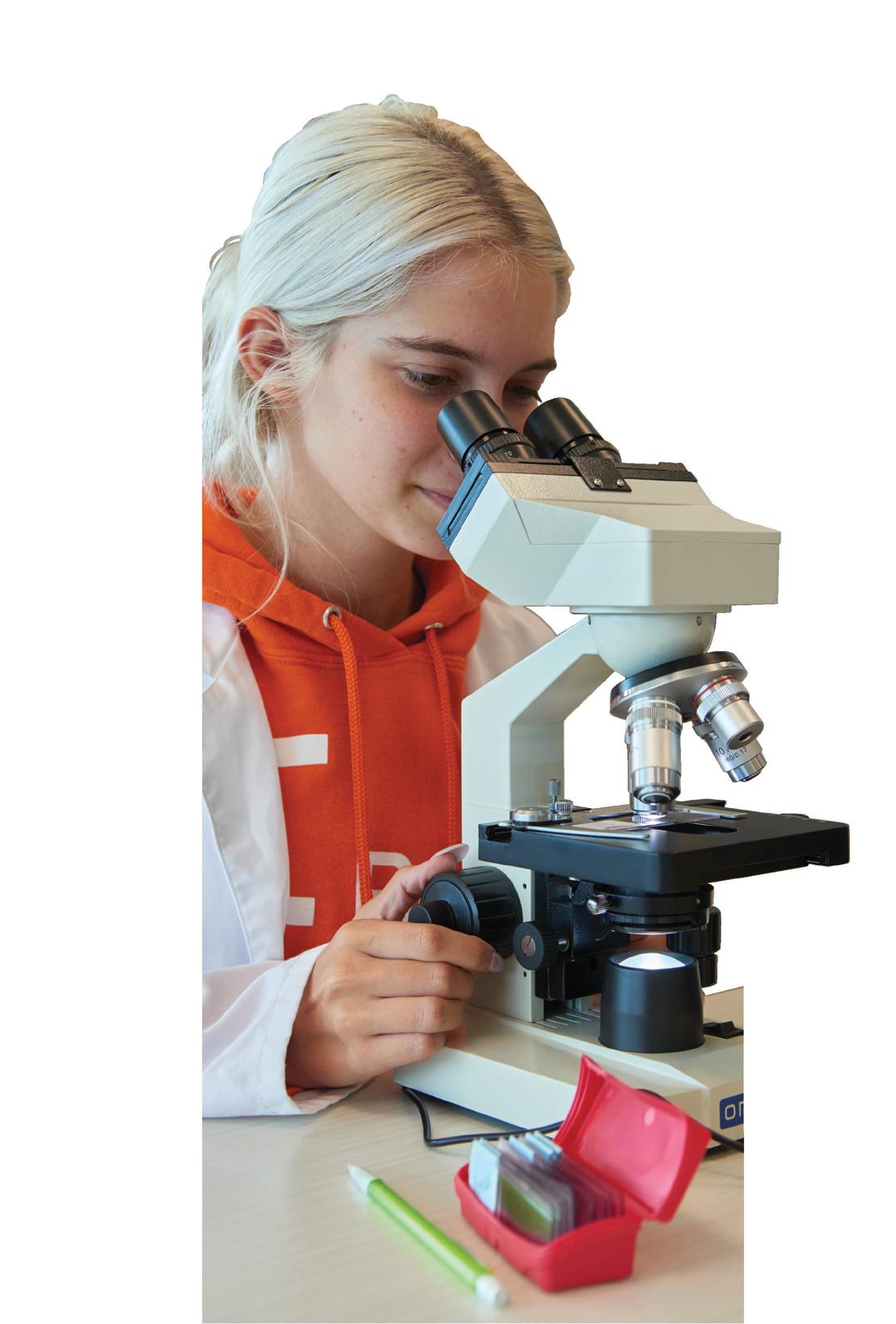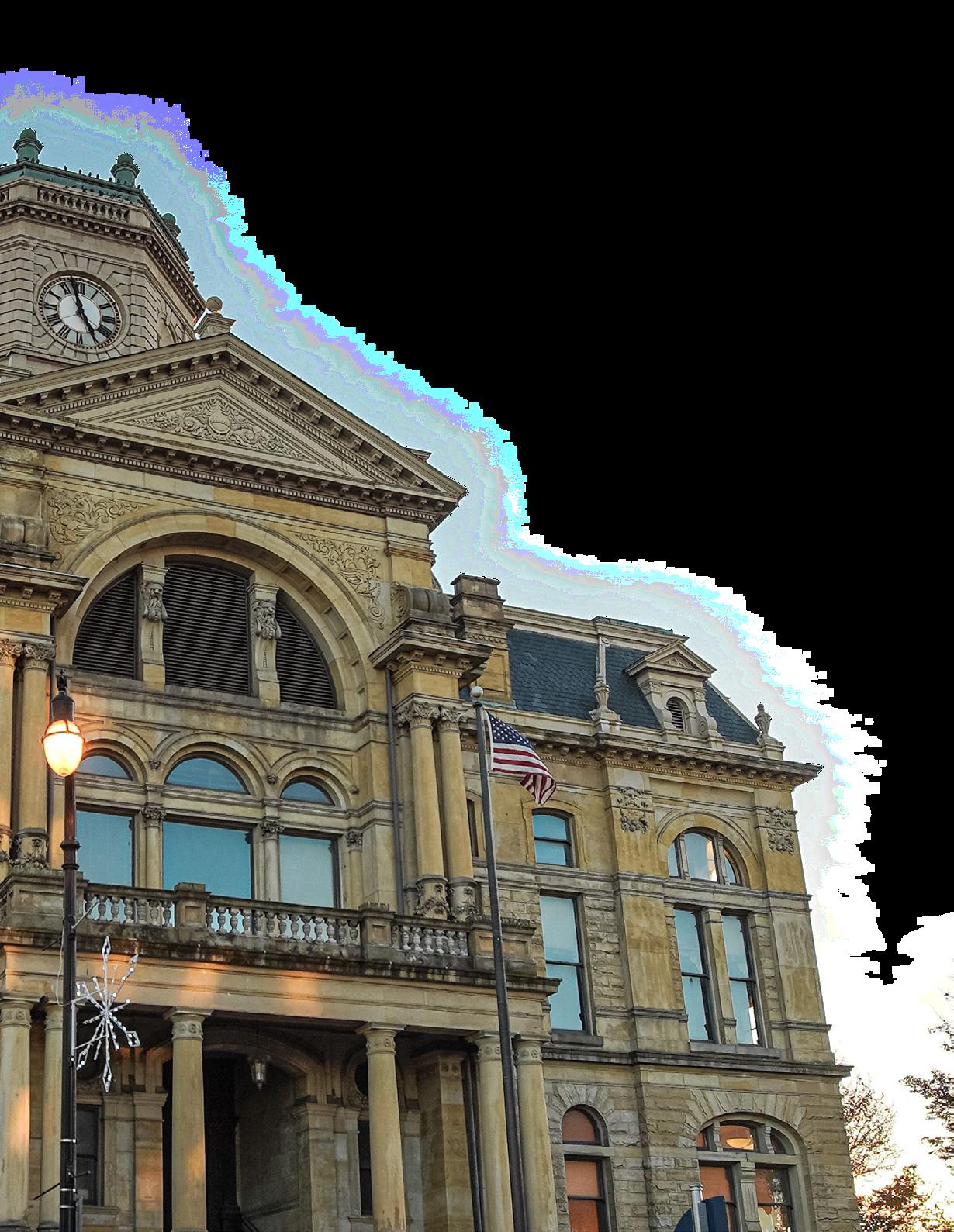




Kettering Health stands at the unique intersection of innovative solutions, award-winning healthcare, resolute faithfulness, and eager hospitality—all while elevating the health and well-being of our communities.



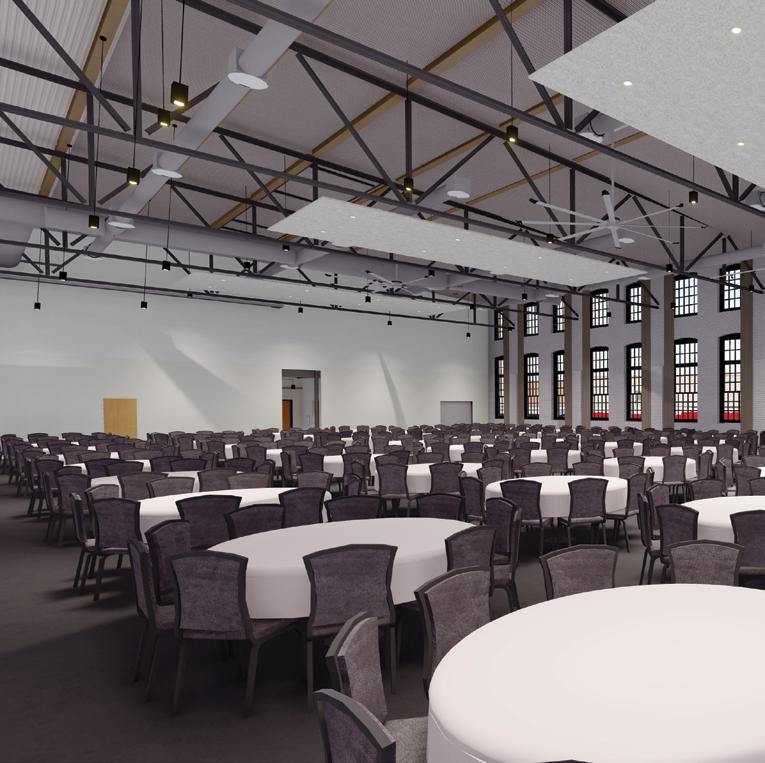



IN 2012, A GROUP OF COMMUNITY LEADERS urged the city to combine all of the important projects, programs, and initiatives into a single annual document that can be shared around Hamilton. For most of the past decade, that publication was known as the Initiative Update and was released annually by the city to showcase recent and upcoming developments in small business, industry, utilities, and neighborhoods.
In 2019, the Hamilton City Council adopted a new comprehensive plan called Plan Hamilton. This plan is not simply the plan of the city government. Rather, it was the result of a year of public input to determine what the city should grow into over the next 15–20 years.
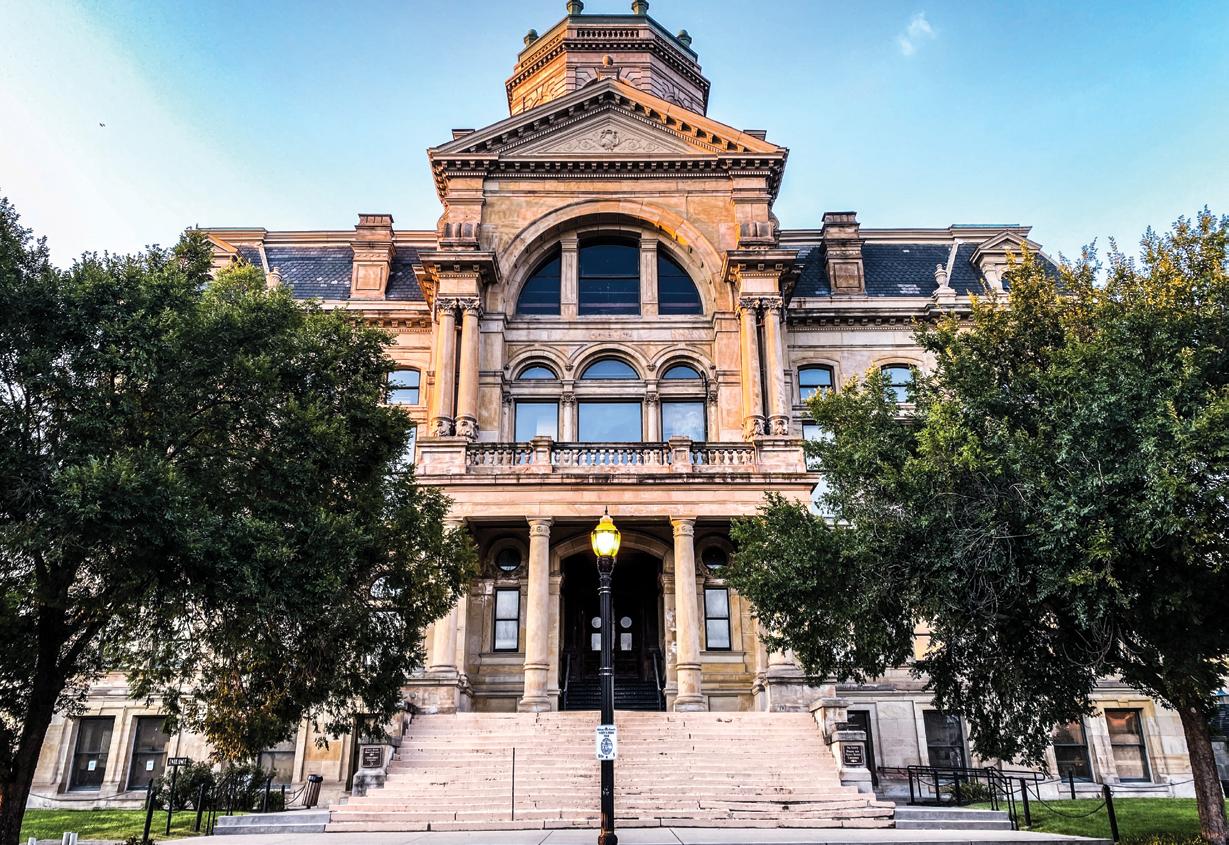
Plan Hamilton is a living document that is constantly evolving with the input of residents and stakeholders in collaboration with the city. As we know from 17Strong … WE is greater than ME.
This issue, a partnership with The Hamiltonian, aims to tell the story of progress on Plan Hamilton. Once a year, WE as a community, can look at this document and ask ourselves if we are making progress on the plans we have made. Better yet, we can ask ourselves how WE will improve upon it.
Publisher

One Pride Publishing, LLP
224 High Street, Hamilton, Ohio 45011
Contact thehamiltonian.store
Photographer
Bailey Osborne
Graphic Design
Eric Marquard
Writers
Kyle Boomershine, Dan Clemens, Richard O Jones, Kieh Kirby
Reid Maus, Megan E. Smith, Maggie Viox
4 Plan Hamilton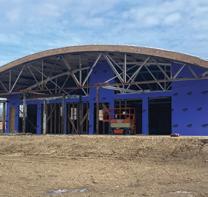
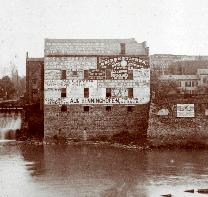

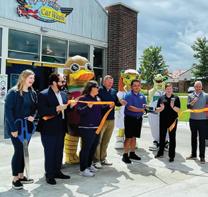

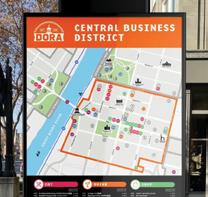


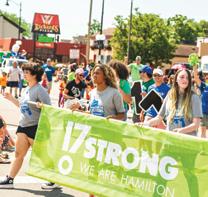


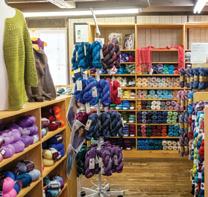


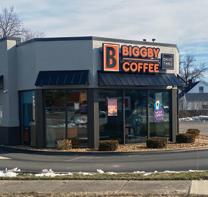
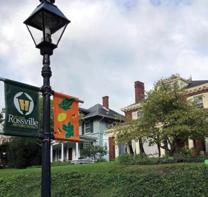
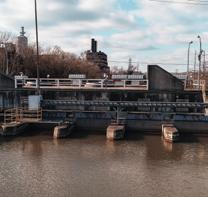
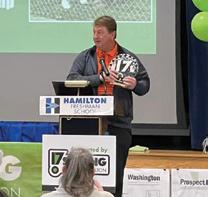
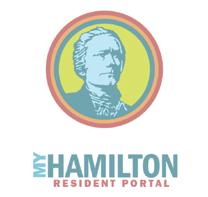
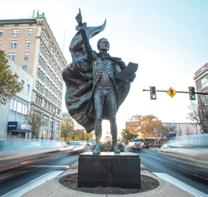
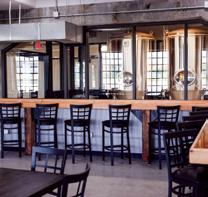


OVER THE PAST DECADE the landscape of businesses in Hamilton’s central business district and Main Street have drastically changed. Seemingly every year now, new signs are displayed on already established buildings along Hamilton’s busiest roads. Soon, thanks to the benefits of a newly
established program, made possible by a partnership between Hamilton’s DORA program, the Greater Hamilton Chamber of Commerce, and Hamilton’s Visitors Bureau, you’ll be able to see all the new additions and stops in Hamilton.
Just under 30 different signs will be spread throughout the city’s recently expanded DORA District in an effort to
attract the expected influx of visitors to local businesses.
“For years and years, the county has had vehicular wayfinding. Like the Butler County signs that say ‘Pyramid Hill.’ But we don’t have a lot of pedestrian wayfinding,” said Mallory Greenham, Assistant to the City Manager. “Through the success of our DORA program, we were able to fund
the design and development of an all new pedestrian wayfinding program throughout all of our urban core.”
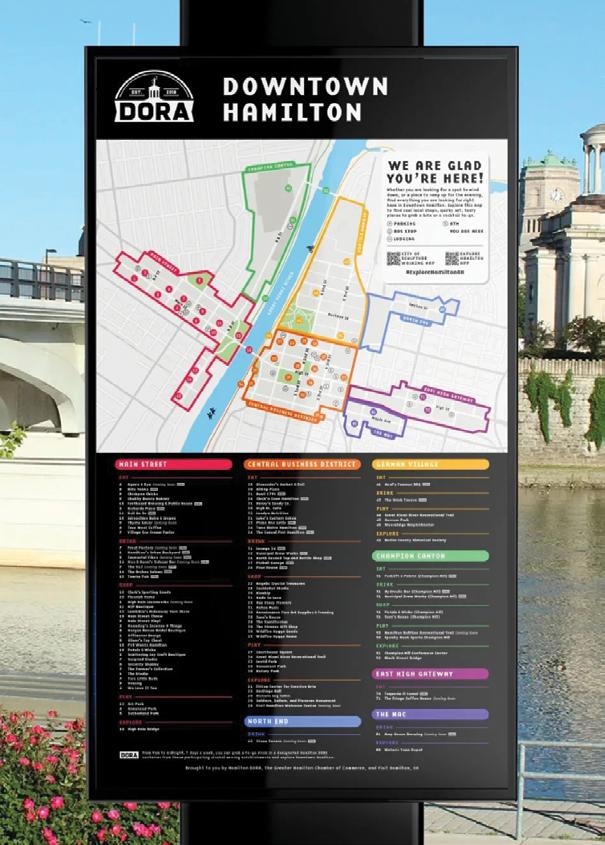
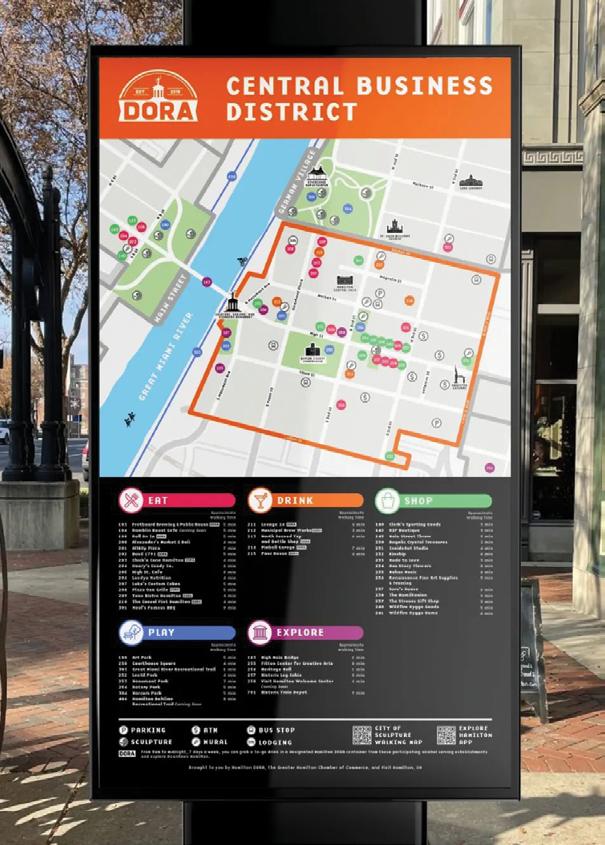
The DORA, or designated outdoor refreshment area, launched in 2018. This past year it expanded its original boundary to include more area surrounding downtown. The sale of DORA cups has played an important role in funding this program.
The wayfinding kiosks will display a map of downtown which is broken up into seven distinct districts: Main Street, the Central Business District, German Village, Champion Canyon, Maple Avenue Corridor, East High Gateway and North End. The map displays 81 different points of interest including but not limited to restaurants, bars, shops and landmarks.
Champion Canyon as a district includes Spooky Nook Sports
Champion Mill. The Maple Avenue Corridor, or “MAC,” will include the relocated train depot and Amp House Brewing. The North End district runs up Heaton Street and will include the Stone Tavern. Those three districts were recently created as a joint venture with this wayfinding program.
One of the main needs for such a kiosk in Hamilton is the rise of expected visitors in the city going forward, thanks in large part to the opening of Spooky Nook.
“We want people to know that they can get to where they want to go on foot. We don’t want people to get in their car all the time,” said Greenham. “The maps will display how long it will take to walk to each place.”
In most places the signs will include three different panels and were all designed by LemonGrenade
Creative. One side will display the downtown walking map, another will have more detailed information regarding the district you’re currently in, and the third side will have other various highlights like upcoming events. These third sides are maintained by the Hamilton Chamber of Commerce.
“We’ve heard from businesses for many years that they’re constantly being asked about what else is out there,” said Greenham. “If you stay at the Courtyard Marriott, it's easy to see Tano Bistro, Casual Pint, Pourhouse, and Chick ’n Cone, but maybe you don’t drive down Main Street.”
In addition to these signs, businesses will pass wayfinding maps out to customers as a way of promoting the rest of local businesses in the immediate area.
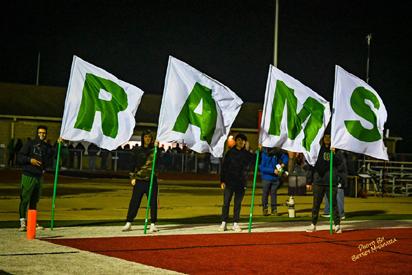



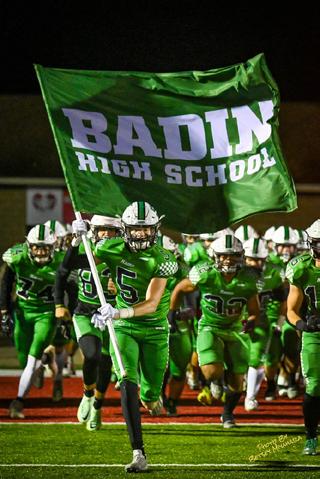


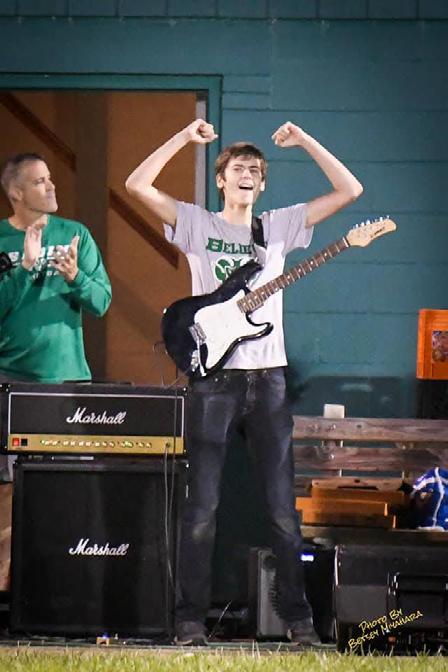
Expected to be completed in fall of 2023.
EXPECTED TO BE completed in fall of 2023, the Rossville Flats mixed-use development represents one of the first new construction projects along historic Main Street in decades. This is the second project for CMC Properties, after their success with The Marcum, and it will add 76 apartments and two
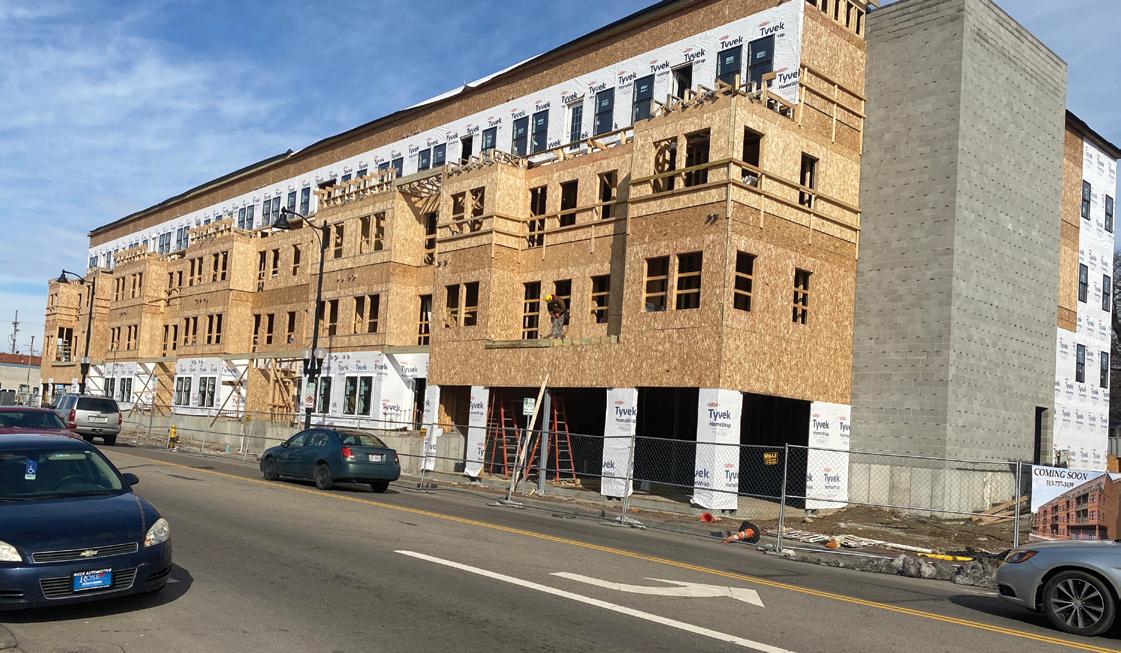
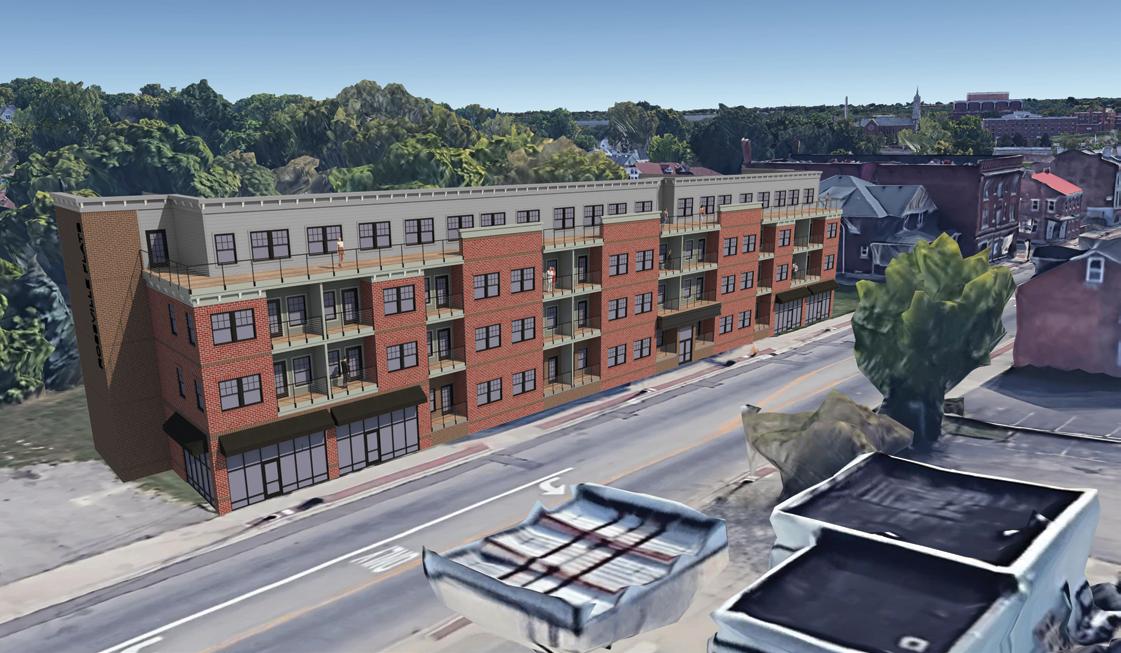
1,600-square-foot commercial spaces to the Rossville neighborhood and Main Street corridor. The addition of more residential units within the urban core continues to add vibrancy to our community and support the growth of recreational, shopping, and dining options.
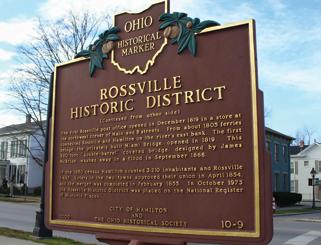
17STRONG continues to be made stronger with community involvement.
NEAR THE END of 2022, the population of Hamilton, Ohio was estimated to be approximately 63,583 people. The City of Hamilton continues to create and enhance programs and services to accommodate the growing population, but the most impactful initiatives that have helped keep Hamilton’s neighborhoods safe, clean, and engaged is 17STRONG.

For more than 10 years, 17STRONG has been building a framework for communication and a sense of identity to rally individuals, groups, and local organizations to take pride in our 17 Hamilton neighborhoods: Millikin, Enterprise Park, Taft Place/Governor's Hill, Washington, New London, Armondale, East End, Highland Park, Jefferson, Lindenwald, North End, Prospect Hill, Dayton Lane, Downtown/CBD, German Village, Rossville, and Riverview.
Today, 17STRONG holds a calendar that is jam-packed year-round with recurring public meetings and community events. Each year, the 17STRONG MicroGrant Program serves residents by providing materials or reimbursable financial support for activities that engage, enhance, and improve the community. Additionally, 17STRONG partners with residentled neighborhood groups to host clean-ups throughout the year. The “Community Clean-up Chest,” a.k.a. “The CUBE,” is Hamilton’s all-in-one neighborhood clean-up package and has become a tangible symbol of good things to come.
Countless volunteers drive 17STRONG, including two who are making moves this year to advance the mission of 17STRONG: Rachel Harding, New London neighborhood lead, and Kyle Cummins, chair of the 17STRONG advisory board.
What and/or who first inspired you to become civically engaged in your community? When did you begin your service?
Rachel: My work with Envision Partnerships is what first connected me to getting involved with 17STRONG. I lead the Healthy Hamilton Coalition and we partner very closely with 17STRONG because our goals are very similar. I would volunteer with and attend many of 17STRONG’s meetings, events, and other initiatives as a community partner from Envision Partnerships, but the more I went to work, the more I wanted to get involved outside of work. When they started asking for someone to volunteer to lead the New London neighborhood, which is where I live, I could not have been more eager for the opportunity to get more involved. This was back toward the end of 2021 and by April of 2022, the New London
neighborhood was having regularly scheduled monthly meetings.
Kyle: I moved away from Hamilton in 2003 and returned in 2019. In the early 2000s, there was a certain amount of negativity regarding Hamilton. Boy, was it a different place in 2019!
I will say the “Better Hamilton” vibes began in volunteer work for 17STRONG at Art in The Park and also at the Hamilton Flea about four years ago. I can recall the remarkable energy at these events, as well as the leadership, that was an inspiration. There are too many folks to name who inspired me to be a part of 17STRONG. So many folks were architects of Hamilton’s renewal and upward trajectory, specifically 17STRONG. I could talk for hours about impactful people.
What do you enjoy most about serving your community?

Rachel: The people, for sure. The relationships I have formed and continue to form, within my neighborhood as well as throughout the city at-large are invaluable. We all have that basic human desire to be connected and feel accepted—getting to be a part of making sure other people feel that, here in Hamilton, is such a privilege and brings me so much joy.
Kyle: Meeting new people! Being able to witness the light in residents’ eyes when improvements have been made, for example cleaning up an entire corner of a neighborhood.
When The CUBE rolls in for a cleanup, people get excited and that is cool to experience firsthand.
What is your favorite 17STRONG memory thus far?
Rachel: My favorite memory is definitely from the first New London neighborhood meeting that 17STRONG organized. New London had not previously had active meetings and I was amazed that more than 50 people were in attendance for the first one. I noticed after the meeting that everyone stayed a while to mix, mingle, and get to know their fellow neighbors better. That stuck with me and made me excited to connect with my neighborhood.
Kyle: It’s a huge list, but if I had to choose one it was the “Love Your Block” program in Lindenwald in the Spring of 2021. It was so cool to see 15-20 volunteers and residents give a beautiful facelift to three to five houses in Lindenwald on Pleasant Avenue. The greatest part was the buy-in from the homeowners who lead these efforts. Love Your Block is a wonderful program and we look forward to continuing in 2023. Stay tuned!
What are your goals in your role to support 17STRONG?
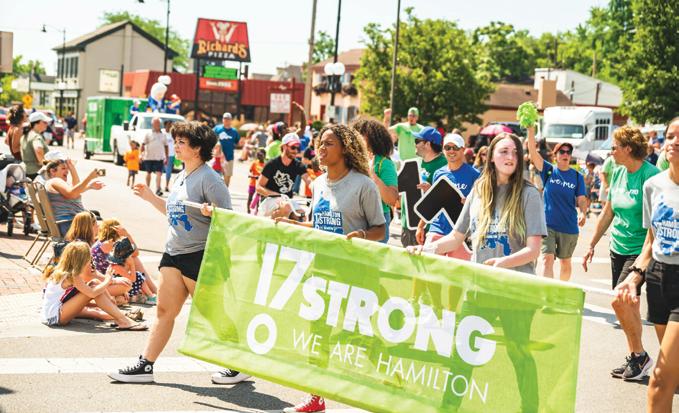
Rachel: The activity of the New London neighborhood is still fairly new compared to some other more established neighborhoods, so my current goal is to increase awareness about our neighborhood meeting times and ways to get involved. I am hoping to expand our reach to more New London residents in the future. We plan on having some guest speakers at the monthly neighborhood meetings, as well as to promote the neighborhood through social media so that staying connected with us is more convenient. We have also discussed maybe planning some events in partnership with surrounding neighborhoods. We have so many options and good ideas coming from passionate residents; it’s a really exciting time.
Kyle: I keep saying to myself, “Kyle, don’t mess this up!” The previous Chair and city legend, Kathy Klink, gave me the keys to a Porsche. Kidding aside, I don’t necessarily see my role changing much. I try my best to adhere to our mantra: “We > Me.” Collaboration between the board to create positive experiences and connect Hamilton residents will remain at the forefront regarding goals. 17STRONG is not about the board, but the residents. Hopefully, we can continue to facilitate wonderful opportunities for others to volunteer. We will continue to reach out to residents and businesses who want to enjoy this wonderful ride.
What do you consider to be the biggest challenge 17STRONG faces?
Rachel: I think the biggest challenge for 17STRONG is reaching and educating the younger population about who and what 17STRONG is. Elementary and middle school students typically only know their home, or maybe their block as their neighborhood. It can be more challenging for them to understand 17STRONG’s concepts and boundaries for neighborhoods and the city as a whole. I think we can find ways of integrating this information to them in a way they will understand, however.
Kyle: It is sometimes difficult to measure success in an outreach event. The board can be our own biggest critic. Sometimes some of the larger wins are meeting one new neighbor who feels undervalued in their community and helping build a bridge for their civic voice and involvement. That may not make it on Facebook, but that is no less important. 17STRONG needs to reach out to all of our neighborhoods, whether they have built-in leadership or not.
What upcoming 17STRONG community project or event are you the most looking forward to shortly?
Kyle: Each January we have our annual Celebration Breakfast, and this year the event was held at the Hamilton High School Freshman
Campus. The event is a celebration and an opportunity to express our gratitude and appreciation for all Hamilton residents who made an impact in our community the previous year. Also, 17STRONG will be hosting an inaugural conference called the Hamilton Neighborhoods Summit in the summer. Stay tuned for more details on what is promised to be a spectacular connection between organizations, businesses, schools, youth, and government leaders to solve problems and create opportunities.
Rachel: I always love the Celebration Breakfast event. Various people from various neighborhoods and backgrounds put time and energy into bettering their neighborhoods and bettering Hamilton for all. This event is truly a time to celebrate everyone’s hard work, dedication, and love for Hamilton. It is reenergizing to see all the wonderful work that was done in the past year be highlighted because it is all resident-driven. It also is extremely exciting to hear about what new things residents are planning that are coming up within the next year. It’s just great.
What would you like Hamiltonians to know about you and/or 17STRONG’s mission?
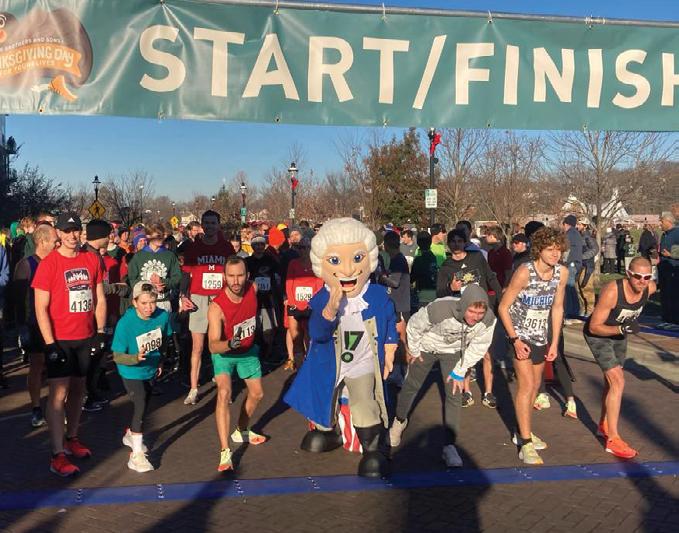
Rachel: I want Hamiltonians to know that 17STRONG is truly a community organization by residents,
for residents. 17STRONG creates space for residents to be heard, take action, and get involved with city government officials and resources, such as funding opportunities. It provides such a unique opportunity where we as citizens are encouraged to get involved with our city to have lasting positive change.
Kyle: I was a tad shy at first about putting my name in the hat to volunteer. Having never really volunteered in Hamilton and been a part of civic service opportunities, I had to step out of my comfort zone. People helped me out, and I would love to pay it forward and lend a hand to somebody else.
What advice would you give to anyone wanting to become more engaged in their community?
Rachel: I would advise them to just start! That is the thing about getting involved—there are so many ways to go about it. Start with whatever you’re comfortable with. That could be simply attending your neighborhood meeting or the 17STRONG general assembly meetings known as the “Better Hamilton Neighborhoods.” Follow 17STRONG on social media, subscribe to the newsletter, reach out and ask questions, share ideas, etc. You can find information about all of these things and how to get involved on the 17STRONG website at 17stronghamilton.org. There you can view a calendar of all upcoming events and sign up to receive information about engagement opportunities. We would love for you to join us!
Kyle: Jump on in! Engagement with the community and volunteering is not only fun but great for personal growth. For starters, you can simply come to our public meetings. Meetings are held on the first Monday of every even month at 6 p.m. in City Council Chambers on the first floor of the municipal building. The gatherings are an open forum for residents to brainstorm ideas that positively impact our neighborhoods. Come say “Hello”… I’m the short guy with a ball cap on.
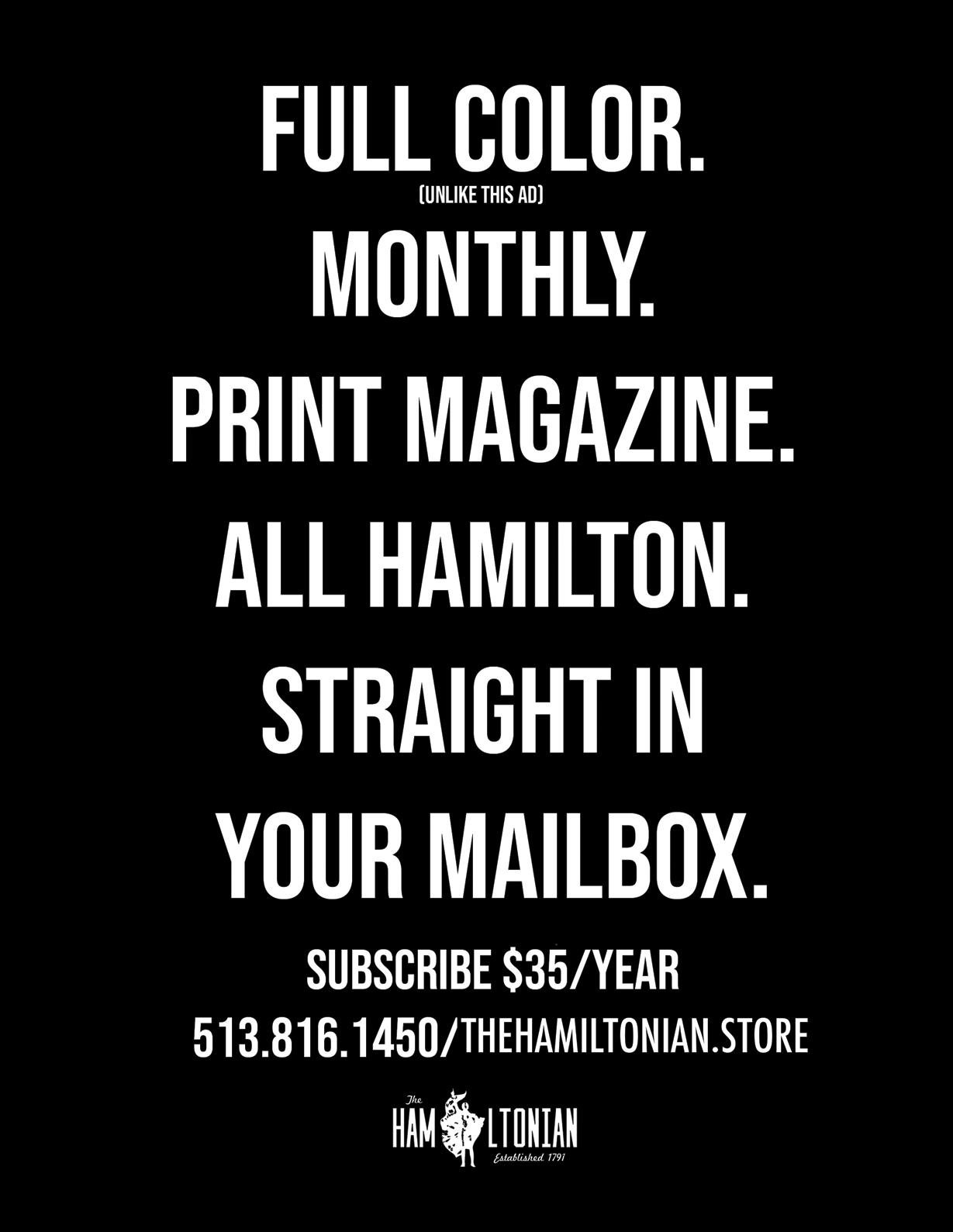
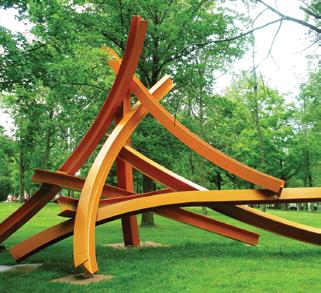
Hamilton is home to a thriving arts scene. Enjoy all the varied and vibrant culture our city has to offer.
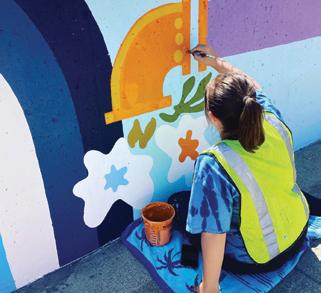

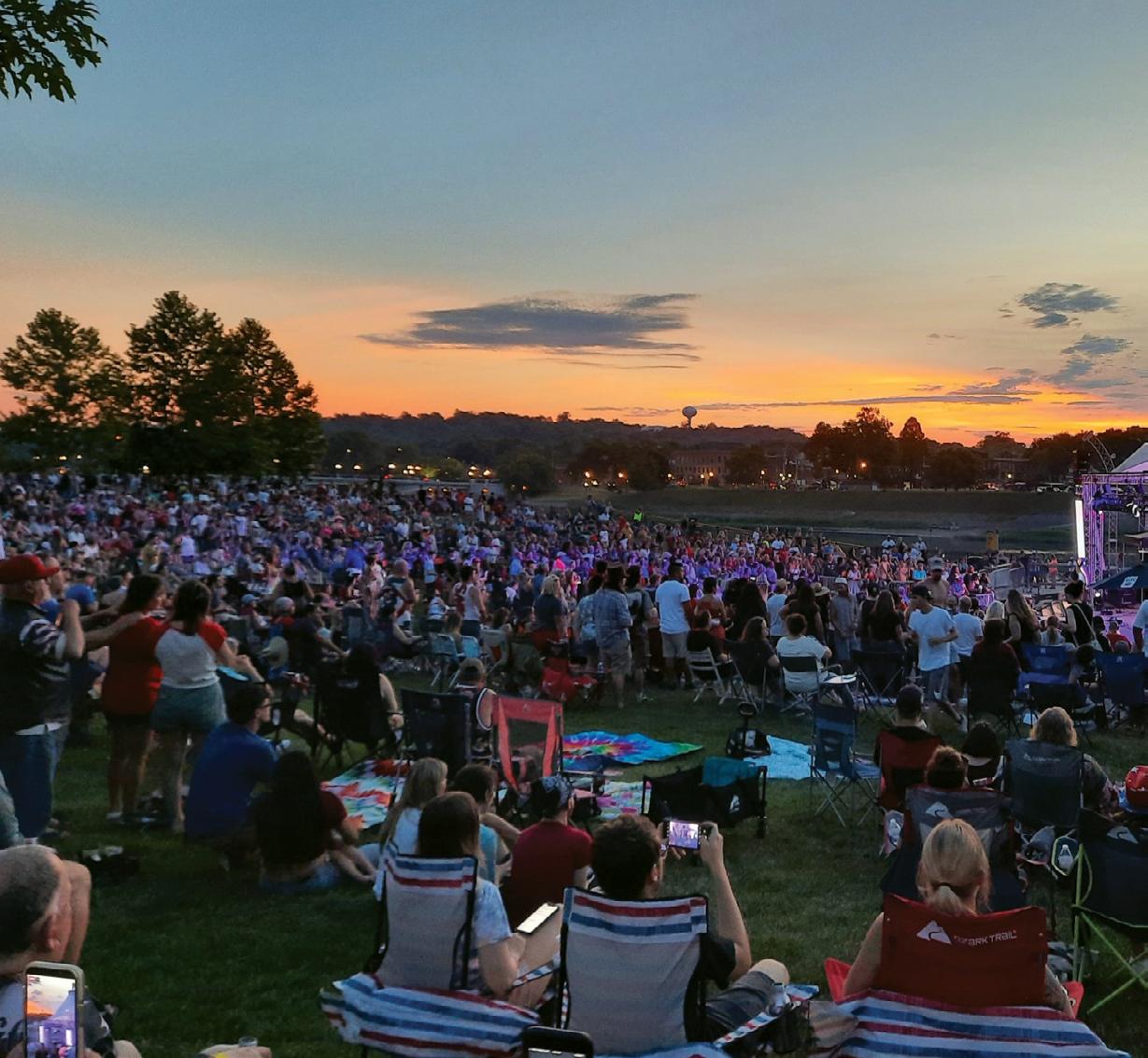
HAMILTON HAS several arts organizations that bring life, culture, and entertainment to the community. These include but are not limited to:
➤ The City of Sculpture Designated by Governor Taft as “The City of Sculpture” in the year 2000, Hamilton is home to an exceptional public collection of more than 55 public sculptures. cityofsculpture.org
➤ Riversedge Amphitheater at Marcum Park A full-service performance venue that is home to a series of free summer concerts and various other events throughout the year. riversedgelive.com
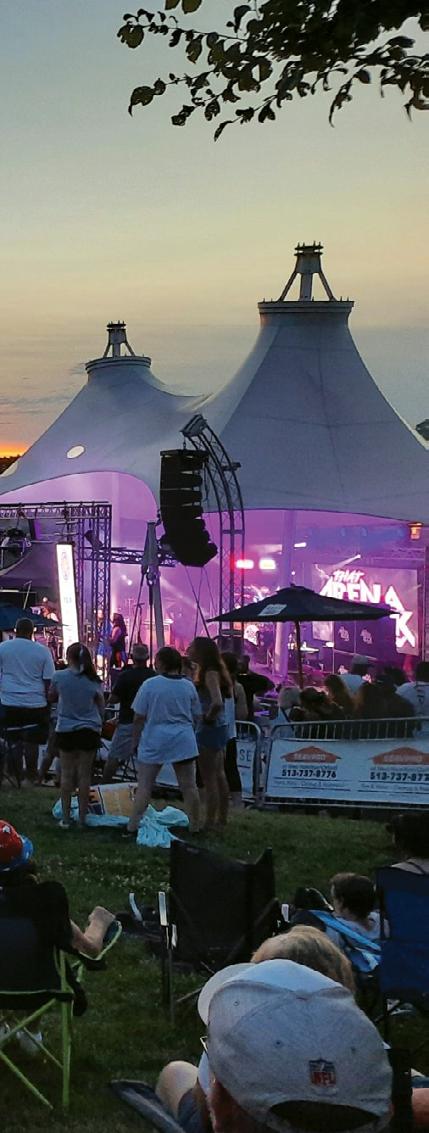
➤ StreetSpark A public art program run through the Fitton Center that has created more than 18 murals in our downtown districts, neighborhoods, and parks. fittoncenter.org/streetspark
➤ Strauss Art Gallery at the Artspace Lofts Local artist-run gallery & gift shop located in the heart of downtown featuring a public gallery and locally made art for sale. straussgalleryandgiftshop.com
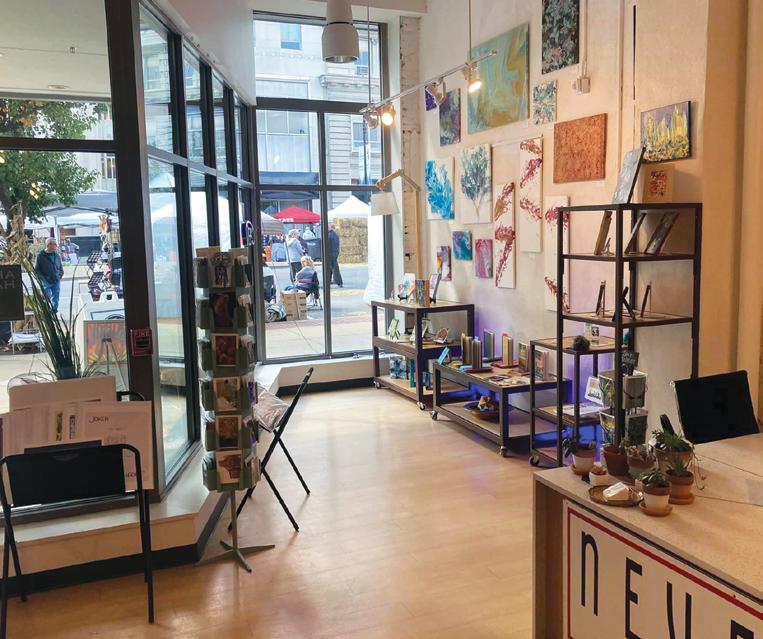
➤ Pyramid Hill Sculpture Park A massive 300+ acre sculpture park featuring more than 80 large-scale sculptures and an impressive ancient sculpture museum that allows visitors to experience art in nature. pyramidhill.org
➤ The Fitton Center for Creative Arts Community arts center offering countless arts education classes, breathtaking performances, and stunning galleries. fittoncenter.org
➤ Greater Hamilton Civic Theatre Community theater offering many shows throughout the year. ghctplay.com
➤ Butler Philharmonic Local orchestra & chorus with performances, large and small, throughout the year. butlerphil.org

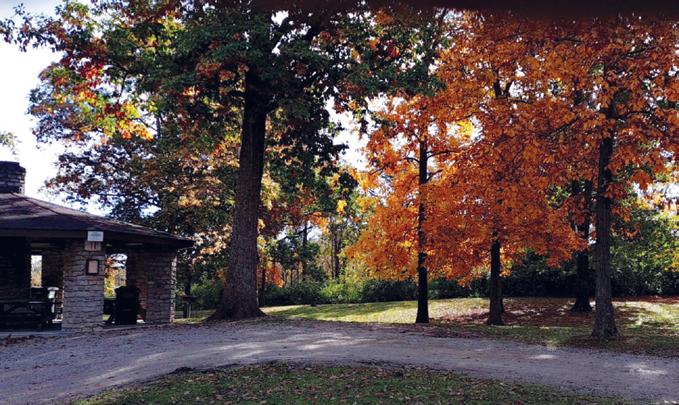
IF YOU’VE EVER spent a summer afternoon at Marcum Park’s sprayground or played a round of frisbee golf at Millikin Woods, then you’ve likely seen the team of people in neon shirts mowing the grass, updating the landscaping or even turning on the water for the sprayground. Those individuals make up the Hamilton Parks Conservancy.
The Hamilton Parks Conservancy was established in January of 2015. The Conservancy focuses solely on managing and expanding the parks located within the City of Hamilton. It was created to provide services to Hamilton residents at a lower cost and to have the ability to conduct fundraising through donations. Our unique park system features 40 parks, two golf courses, multiple spraygrounds, recreational facilities, and over 1,300 acres of natural and wooded parkland, including five dedicated natural areas.
Director Adam Cornette joined the Hamilton Parks Conservancy team in January 2022. Cornette brings years of experience from his previous job for a traditional-style Parks and Recreation Department within the City of Blue Ash. Even though this is his first experience with a conservancy, founding director Steve Timmer showed him the ropes before retiring as director and moving into a different role at the conservancy.
“The Parks Conservancy focuses
on improvements within the city and a better quality of life for its citizens. We are a 501(c)(3) nonprofit. We’re not in this to make any money, we’re just focusing on what we can do to improve our infrastructure and accessibility. We’re building a new park off of Gordon Smith Boulevard that's probably going to be ready in early spring. We had a survey done to see how much of the population can reach a park within ten minutes of walking, not using a vehicle or
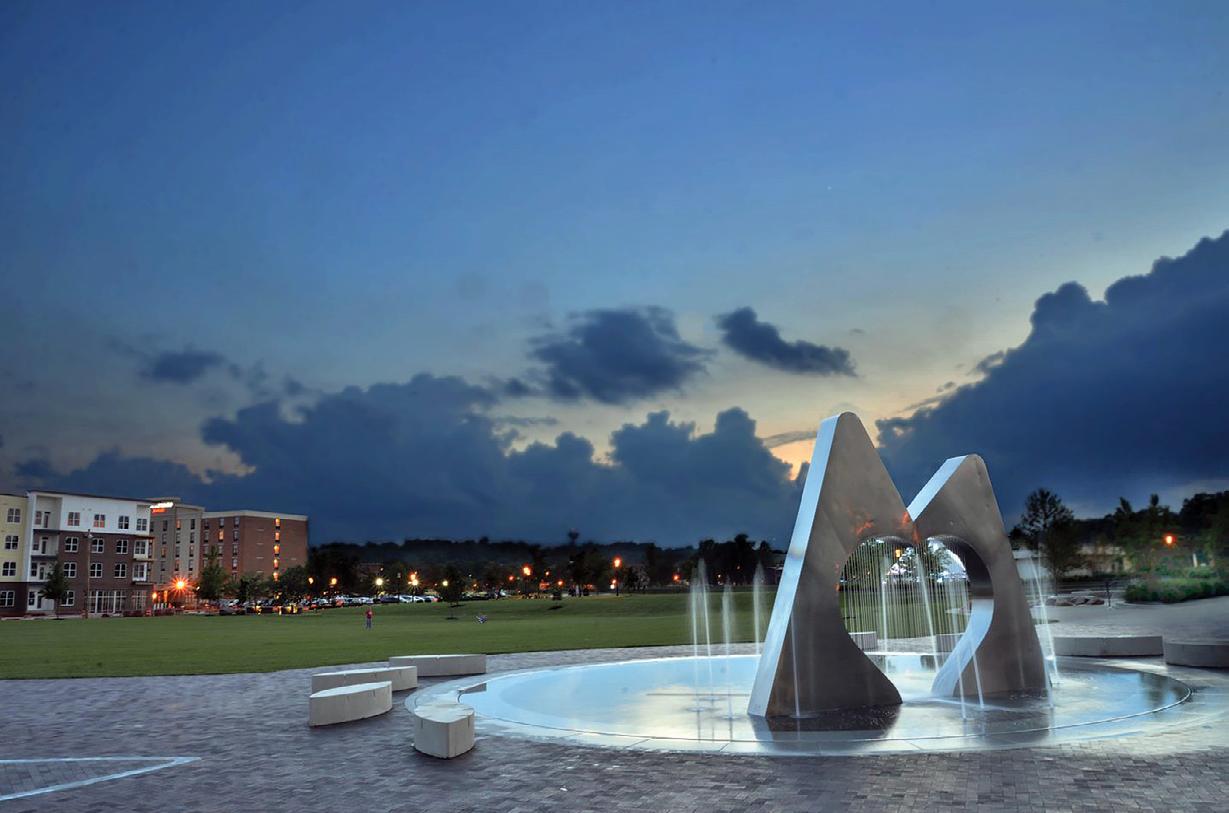
public transportation. The previous survey results in 2019 put us in the 75th percentile, which is good. But just adding that one park in an underserved area brings us close to the 90th percentile. That means in 2023, almost 90 percent of our city population will have access to a park just by walking.” stated Cornette.
The Conservancy approach ensures the parks and their budget are a priority instead of the possibility of being shoved to the side when it’s included in a large city budget. Having a separate budget from the city keeps the quality of care consistent. 17STRONG has been a massive asset in getting our neighborhoods together to improve their homes, streets, parks, etc. Different neighborhoods now have monthly meetings, such as the Lindewald PROTOCOL (People Reaching Out To Others: Celebrate Our Lindenwald) where the Parks Conservancy can hear directly from citizens about their unique needs.
“It’s an accountability we have to give the city what they need and give the citizens what they need without worrying about as much of the government red tape that we used to have in Blue Ash. We’re able to improve the parks for people to use them, not just in how they appear. The biggest benefit for us as a conservancy is the ability to accept donations. We have an account over at the Hamilton Community Foundation
for those donations. They can be as restricted or unrestricted as the person donating chooses. Someone can donate specifically to frisbee golf maintenance at the parks. They know where their money is going. We’re very transparent about our budget and how we use donated funds.” explained Cornette.
The conservancy model has allowed Cornette’s team of 15 fulltime employees and over 70 seasonal employees to strategically plan with the future in mind. “It’s been challenging to change my mindset from what do I need to do at this facility today, tomorrow … Instead here [at the conservancy], it’s what are we doing this week, next year, 5-10 years…It’s adjusting the mindset to the entire system as a whole rather than one individual facility. Steve was a great help working closely with me to share as much knowledge that
he had at the time about how we operate and make certain decisions. He transitioned over to a project manager role to help with our capital improvements which frees me up to address other things,” said Cornette.
Hamilton is not the first city to shift their Parks and Recreation Department into a separate Parks Conservancy but not all of them have been nationally ranked as Hamilton has. In 2018, Marcum Park was named one of the five great public spaces by the American Planning Association. The state of Ohio has only 12 places recognized, and Hamilton is one of them! Additionally, the city has taken part in a National Community Survey regarding our parks system. Here are the results:
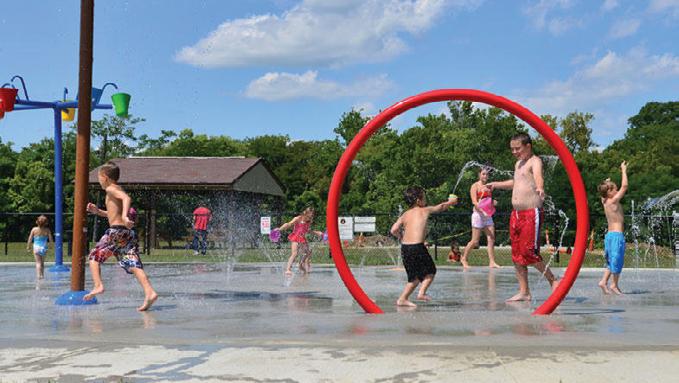
2011 (before the HPC): 59% of citizens surveyed are satisfied with our parks
2015 (first year of HPC): 61%
2017: 74%
2019: 81%
The move from a city department to a conservancy has been a successful decision. The results above show that over the years, more and more Hamiltonians are pleased with our parks than before the transition.
So, the next time you visit a concert at RiversEdge, make a splash at Crawford Woods, or enjoy a movie in the park, know that this team is working year-round to guarantee a clean and enjoyable experience for all Hamilton residents.

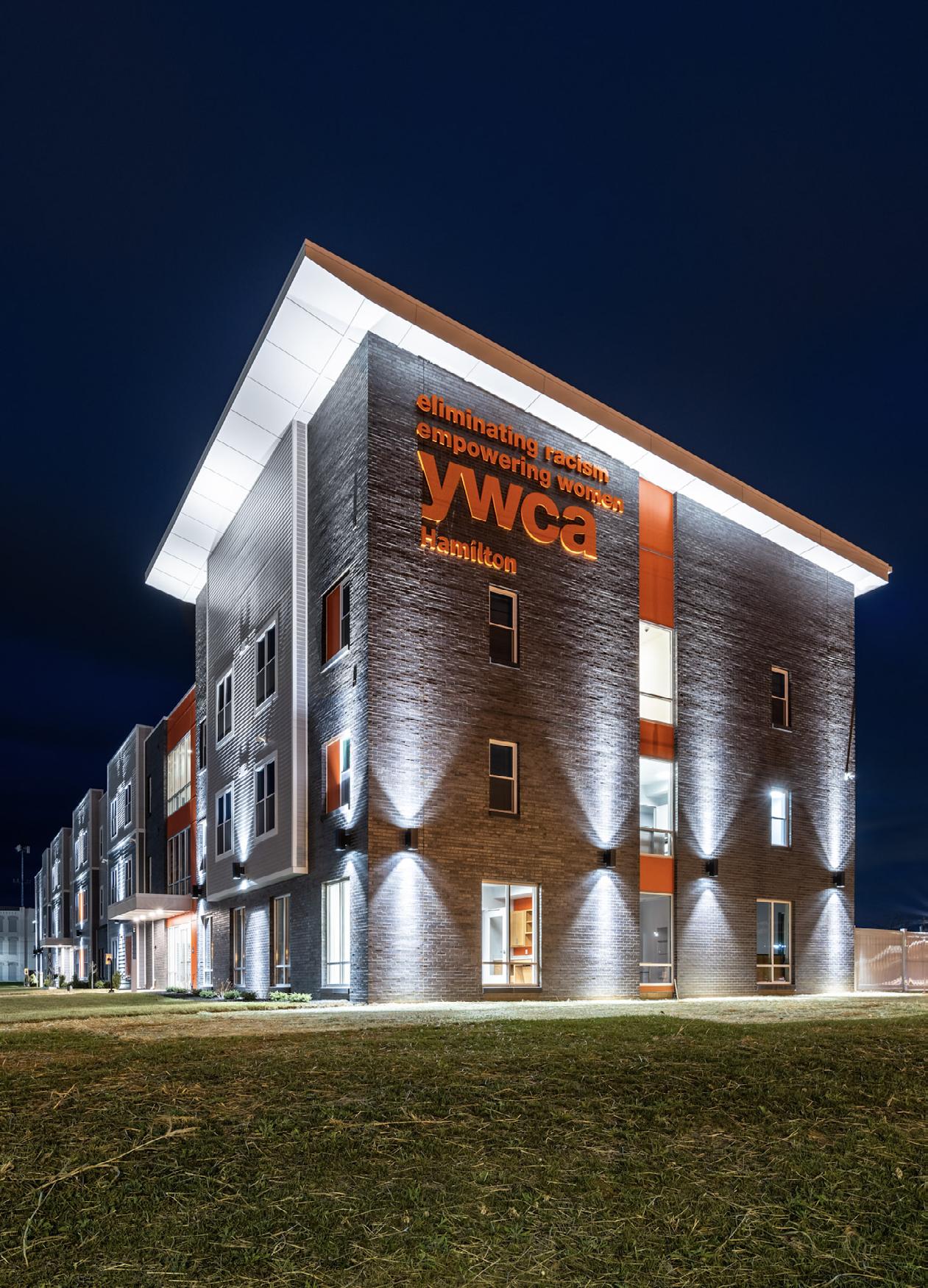
REDEVELOPMENT of Route 4, a highly traveled corridor in Hamilton, is catching its stride. With a daily traffic flow of over 20,000 cars, the Third Eye Brewing project is a major part of the area's recent investments. The $3.1 million development of the former
Pepsi Bottling Plant, boasts a state-ofthe-art 10,000 square foot production facility and a spacious tap room, complete with a full-service kitchen. Scheduled for completion later in 2023, this project is sure to be a game changer for the area.

Nearby, the YWCA recently opened its doors to a brand new $11 million facility. The development momentum along Route 4 is palpable, and we eagerly anticipate the exciting new possibilities that lie ahead for this corridor.

IF YOU DRIVE down the major roads in Hamilton your eyes get drawn to the new businesses that seemingly are popping up by the dozens. Citizens get justifiably excited about the landscape of the city’s dining and entertainment options, but rarely stop to think about the collateral benefits that a thriving economy can bring to a community.
The renaissance of Hamilton is exactly that, a rebirth. The businesses that have built a legacy in this town are stronger than ever and are still bringing prosperity to Hamilton— perhaps most importantly, they’re still offering employment opportunities for Hamiltonians.
“There was a time when we were dominated by maybe a couple of industries in the city,” said Jody Gunderson, Hamilton’s director of economic development. “While those companies are great, you can’t have all your eggs in one basket.”
Hamilton has done a fantastic job at recruiting companies, to not only stimulate the economy but make it so that we aren’t at the mercy of the
they were going to expand, and they expanded into a new facility in Hamilton, in preparation for their next 100 years. That is quite the compliment to the city and its residents.”

For decades, after the initial boost of expansion within the city limits, people and companies began to look outside and move to the suburbs.
and Matandy/Linrose have created a benefit to both themselves and their employees by staying in business in Hamilton’s classic neighborhoods like Lindenwald. By staying in town they’re benefitting from the city's reliable utilities and creating shorter commutes for their workers. Almost giving a throwback to 100 years ago,
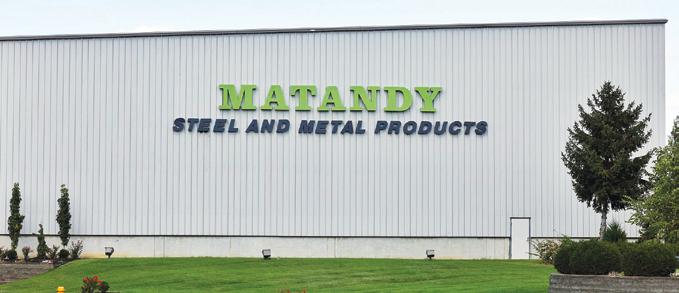
ebbs and flows of just one industry.
“I think we have done a fantastic job at focusing on the diversification of the types of companies that we are recruiting,” said Gunderson. “It has served us well.”
The combination of new industries creating jobs and the companies that stayed here in the City of Sculpture have curated a sustainable influx of opportunities for citizens. Four thousand jobs have been created in Hamilton over the past decade.
“When it comes to legacy companies, like Hamilton Caster, which has been around for 120 years, there are lots of opportunities to look elsewhere,” said Gunderson on companies having a chance to leave. “They decided
America saw this across the country and now people and companies are coming back. Hamilton has to showcase its best attributes to recruit businesses to come to town and stay.
“We spend a considerable amount of time evaluating what [Hamilton’s] true assets are,” said Gunderson. “New companies typically are reliable utility customers. Whether it be electricity, water, or natural gas, all of those things need to be incredibly reliable. Hamilton has been in the utility business for over 100 years, and in that period we’ve gotten better and our infrastructure has gotten better. That attracts a lot of business to Hamilton.”
Along with Hamilton Caster, companies like Kaivac, Darana Hybrid,
when employees would walk to work.
“It’s very interesting, it’s kind of the old is new again,” said Gunderson on these companies once again being in the same neighborhoods where their employees live. “It’s not the necessity that it used to be, but it’s a benefit to both parties.”
Companies get the reliability of having an employee live close by, while the resident spends less time commuting, and in turn, more time with family.
Through recruiting new companies to expand inside of Hamilton, while simultaneously taking care of legacy businesses that have long been staple of this town, the city is building a thriving economy within the community.
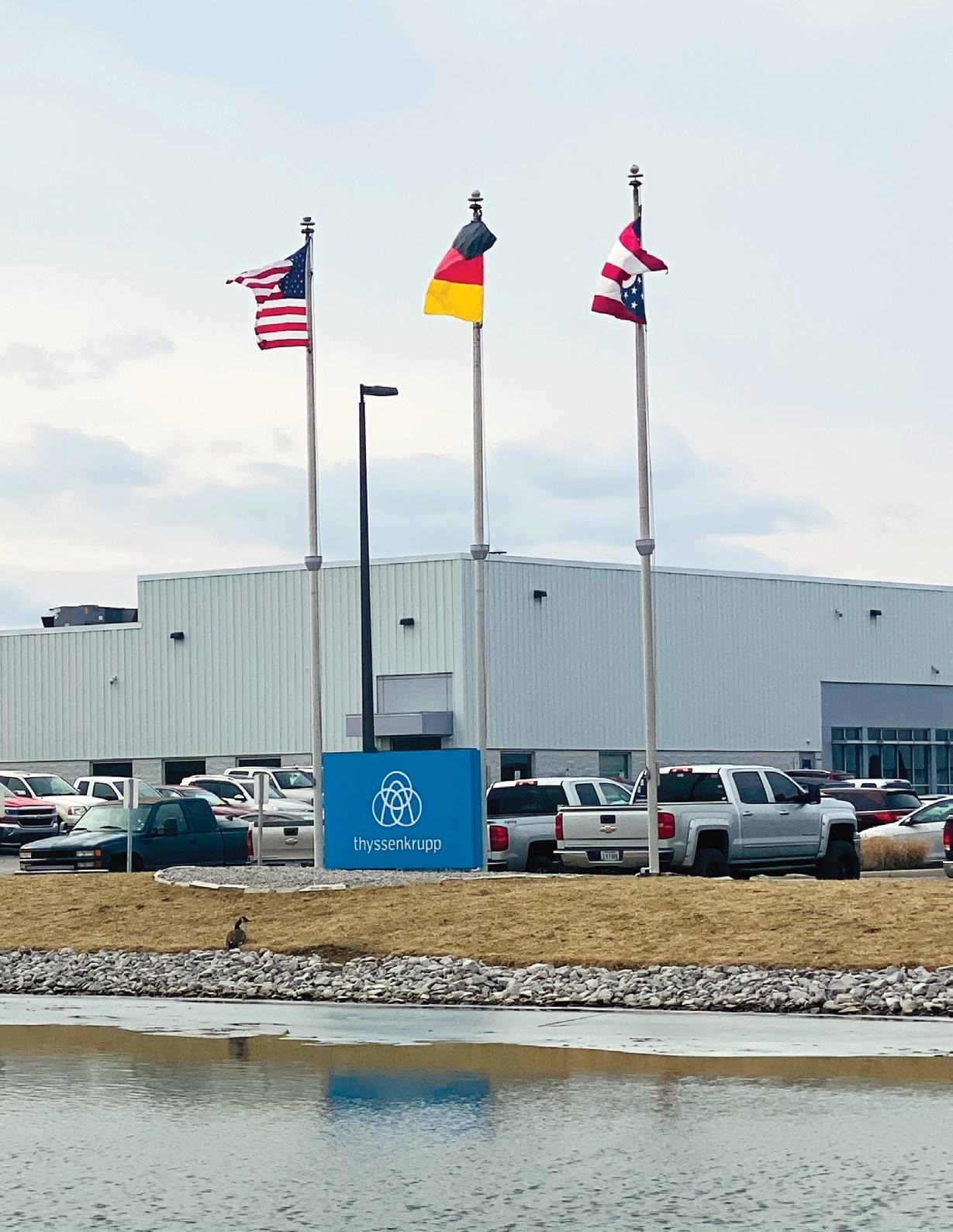
New in '22! Businesses in Hamilton that have opened or are coming soon.

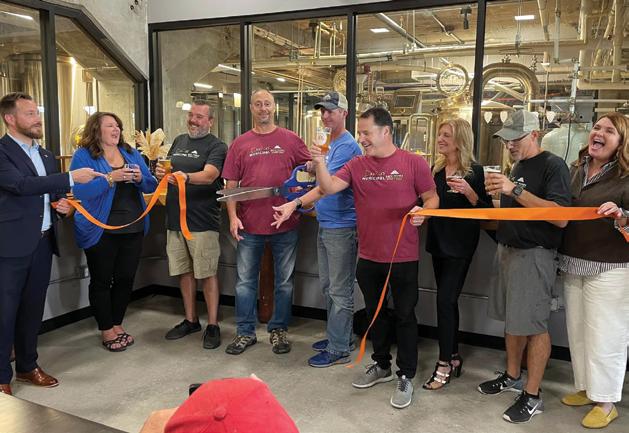
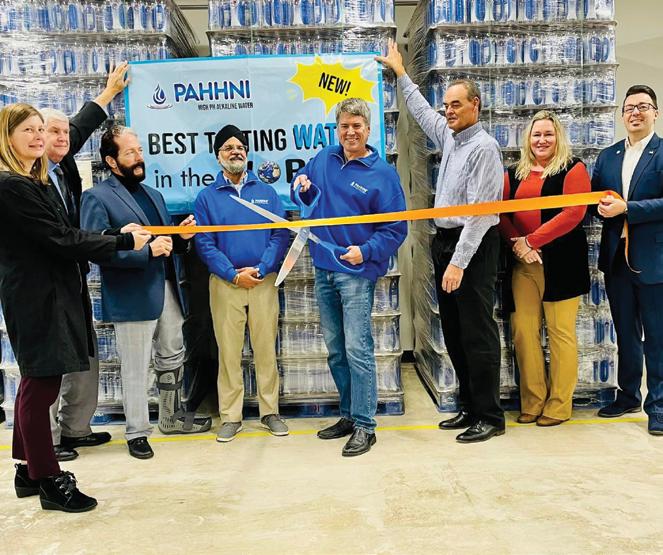
FLYING ACE EXPRESS CAR WASH
 1. Dulce Pecado
2. Harley Uzed Apparel & Parts Boutique
3. Kinship Teas
4. Luke’s Custom Cakes (expansion)
5. Morgan Renae Bridal & Event Venue
6. OffCenter Designs
7. Oliver’s Toy Chest
8. PAHHNI Water
9. Pohlman Lanes (expansion)
10. Pour House
11. Rose of Sharon
22 Plan Hamilton
SERAPH BY THE RIVER PAHHNI WATER
1. Dulce Pecado
2. Harley Uzed Apparel & Parts Boutique
3. Kinship Teas
4. Luke’s Custom Cakes (expansion)
5. Morgan Renae Bridal & Event Venue
6. OffCenter Designs
7. Oliver’s Toy Chest
8. PAHHNI Water
9. Pohlman Lanes (expansion)
10. Pour House
11. Rose of Sharon
22 Plan Hamilton
SERAPH BY THE RIVER PAHHNI WATER
18.
Coming
15. The Landing
16. Tide Pool/Welcome
17.
Coming
1. Pinball Garage


2. Forklift & Palate
3. Sara’s House
4. Petals + Wicks
Coming Soon–Chains

1. Ace Hardware
2. Panda Express
3. Starbucks

Utility
“TONIGHT WE TURN A LEVER and press a button and behold, the heavens are ablaze with light!" proclaimed Nelson Williams, a lawyer, civic leader, and feature speaker of the Great Electric Light Celebration of 1895. The occasion was to earmark the completion of the first municipal power plant on North 3rd Street.
The modern marvel of a facility featured a pair of arc lighting machines providing 120kW of electric power and three Corliss engines manufactured by Hamilton’s own Hooven, Owens, & Rentschler Company. Electricity was set to be a huge benefit to Hamilton residents as
it was expected to provide residential lighting at 40 percent the cost of gas and to be available 24/7. At the time, gas lighting was only available through a private company from twilight until midnight each day.
A parade, band concert, and official program around the Butler County Courthouse kicked off the celebration that was accented with a 50-gun salute, ringing fire bells, and fireworks. And, as promised, with the turn of a lever and a push of the button, the first 215 city street lights “set the heavens ablaze with light.”
Over the next 50 years, Hamilton’s electric generation grew in step with the growth of demand and
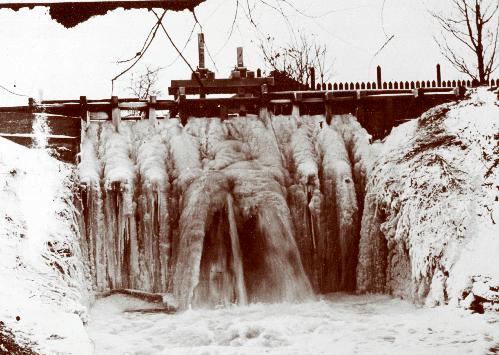
soon the scale of our systems called for increased connection with the regional grid. Today, Hamilton meets our customer energy needs through a well diversified generation portfolio that includes rights to power and generation that we own and operate, located throughout the midwest. Hamilton relies on our in-city generation assets primarily to provide support on peak power usage days. Days which now demand in excess of 1,000 times more energy than the inaugural plant was capable of.
HAMILTON HAS LONG BEEN a leader in renewable energy, focused on the
development of environmentally conscious power supply for our system. As early as the 1840s, hydropower generated from the Hamilton Hydraulic System was fueling manufacturing in Hamilton. Today, more than 50 percent of the city’s power is sourced from renewable energy. Hamilton operates and maintains a majority stake in both the Meldahl and Greenup Hydroelectric Power Plants on the Ohio River, and generation rights to a number of other carbon-free assets. Additionally, these hydroelectric resources provide our customers a reliable source of energy and long term price stability.
For our every day customers the renewable energy certificates (RECs) associated with our hydroelectric plants are sold to the market helping save on power costs. Once the RECs are sold, that energy is not considered to be “renewable.” While the value of those credits changes with the energy market, as of this writing this practice is saving our average customer more than 2 percent on their electric costs. For customers who want renewable energy there is our EcoSmart Choice program. Commercial and industrial customers can opt into the program, run through American Municipal Power, Inc. (AMP), that supports renewable energy development from a variety of
sources, such as hydroelectric, landfill gas, solar and wind facilities. EcoSmart Choice allows Hamilton customers to add an allocation of their electricity usage to renewable energy certificates (RECs) to receive up to 100 percent green energy.
A special thanks to the late Jim Blount and the Lane Public Library’s Historical Collection for historical reference materials used in the creation of this article.
Photos used are courtesy of the George C. Cummins "Remember When" Photograph Collection at the Hamilton Lane Library.

HAMILTON'S ROLE IN ENERGY PRODUCTION GOES BACK TO THE 1840 S . THE CITY CONTINUES TO BE AN INNOVATOR TODAY.
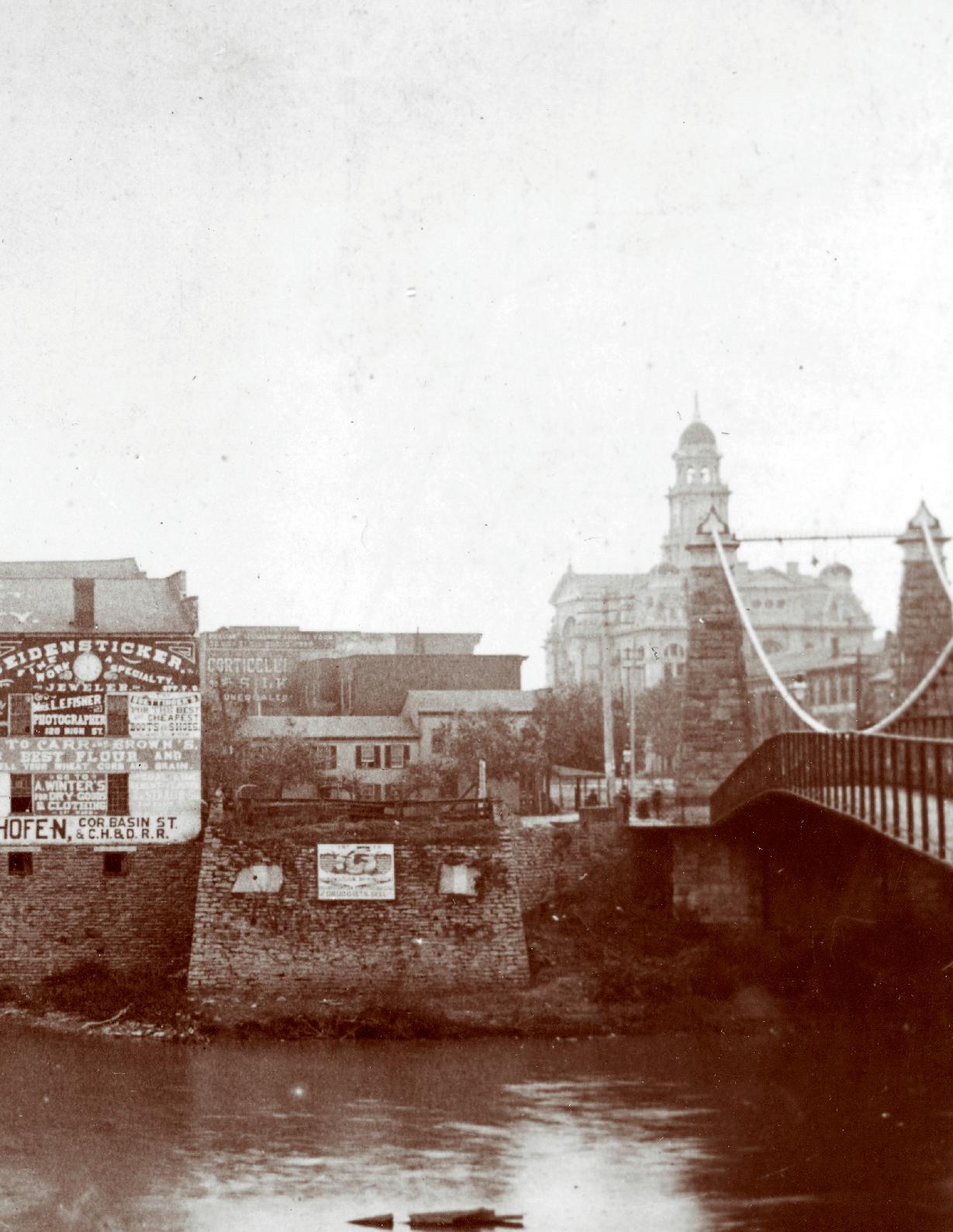
↑ HEADGATES FOR HYDRAULIC FEEDER, 1905.
The
Since 2012, the City of Hamilton has been focused on improving traffic flow through our primary High/Main Street corridor by systematically addressing problematic intersections including: Erie Boulevard (Route 4), MLK Jr. Boulevard (US 127), Eaton/Millville Avenues, and Cereal/Haldimand Avenues. The next step of this process will be to upgrade and install new traffic signal hardware to improve traffic operations throughout the city. The full potential of these intersection improvements will be evident in 2023 as our new central-based traffic signaling system comes online.
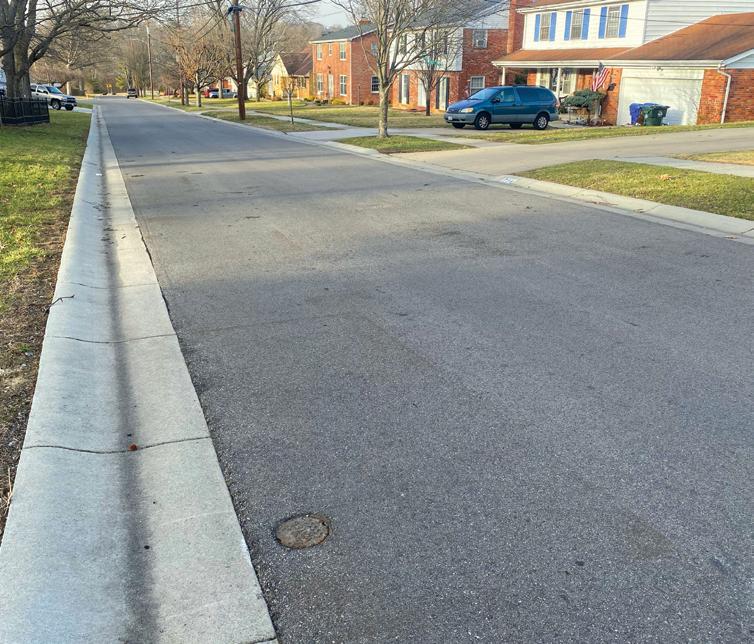
This new technology will allow our traffic control network to automatically adjust signal timing and proactively change timing to increase traffic flow. This means that when we experience a surge of traffic in one area due to a large event or accident, the system will adapt in real-time to allow that traffic to clear more quickly. Additionally, the new system continuously collects traffic data as well as gives city staff

flexibility to monitor and adjust traffic operations remotely. The total cost of these transportation improvements is $5.2 million, of which $4.2 million is being funded by an OKI Surface Transportation Block grant.
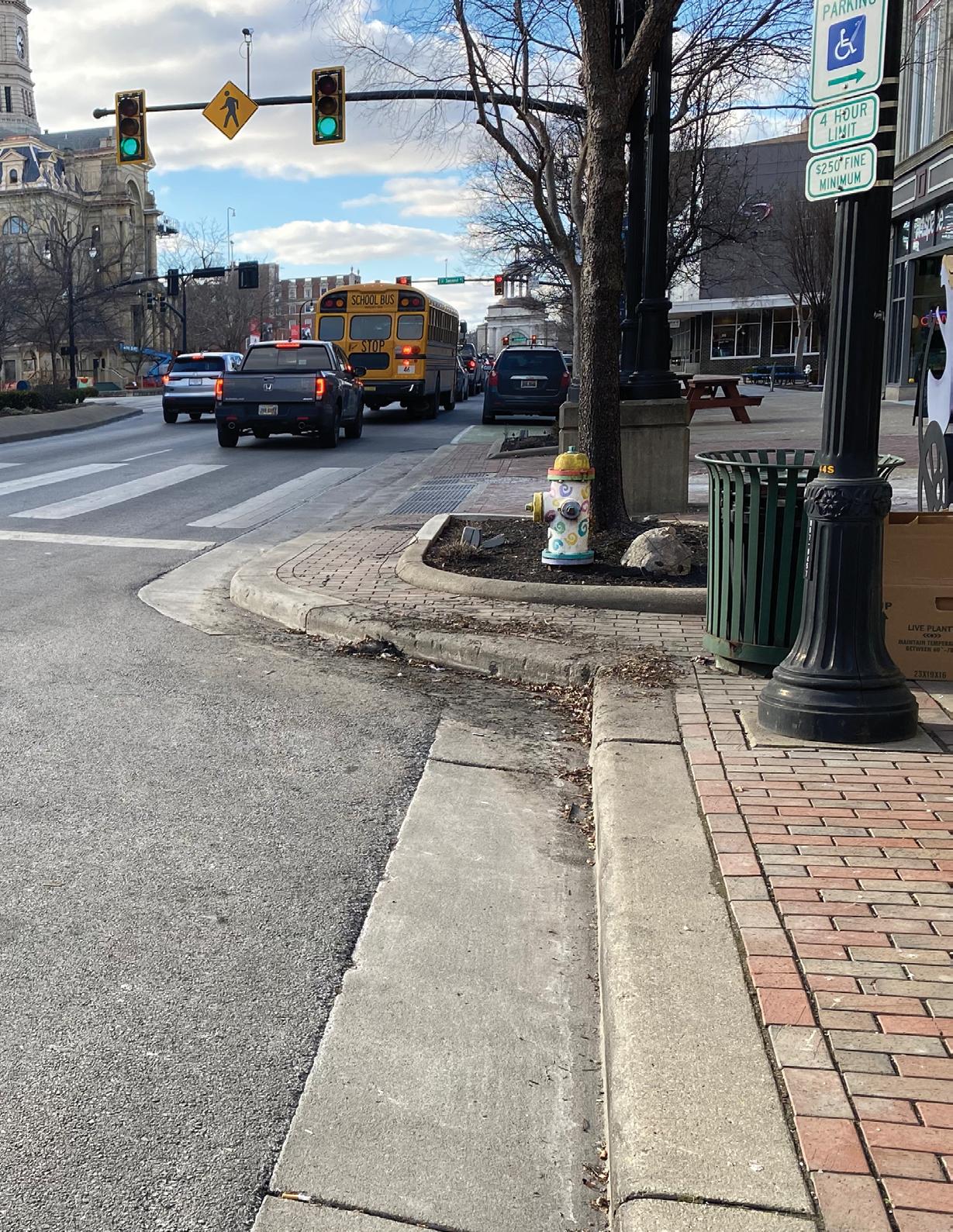
Hamilton residents passed a streets levy in 2020 that runs from 2021-2030 and City Council has said that the proceeds from the levy funds will be distributed proportionately to each neighborhood. For instance, if a neighborhood contains 5 percent of the streets in the city, it will receive 5 percent of the proceeds from the levy over that decade. We currently have about $3.5 million in road work under construction. To learn more about which streets are being paved and what percentage of the streets your neighborhood has, go to www.hamilton-oh.gov/streetslevy. At this same link, you can also submit a form to let the City know which streets you’d like to see paved and learn about the factors that impact decisions on which streets are paved.
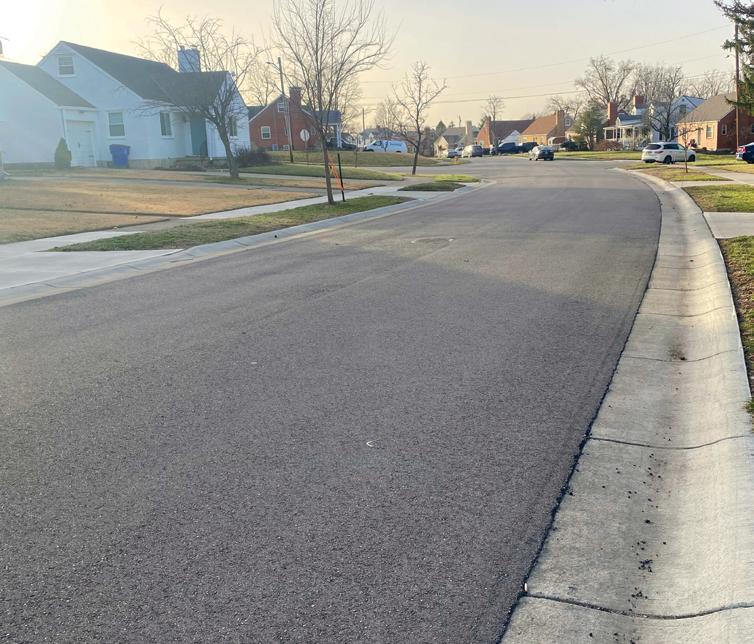
THERE ARE HUNDREDS of businesses located in the city limits of Hamilton. There are many that have stood the test of time, some for over 100 years! A few of the oldest that come to mind are Hamilton Caster, Butler County Lumber, Al-Joe's Pet & Garden Center, Wilks Insurance, Richards Pizza, Jolly’s, Community First Solutions, Holiday Auto Theatre, Matandy, Flub’s, Hyde’s Restaurant, Triangle Sign Company, Kaivac, Vision Source, Max Stacy Flowers, Rose Automotive, Neal’s BBQ, YWCA and Bethart Printing.
Ten years as a business is also a worthy accomplishment! True West Coffee, Community Design Alliance, The Main Look, Lambikin’s Hideaway, Inside Out Studio, Miami Valley Ballet Theatre, Made to Love, Two Little
Buds and Sara’s House have hit this milestone. It’s encouraging that our town has so much legacy in it through local businesses, and this is only a partial glimpse of it!
We were able to chat with a few of these businesses to hear more about the success of their business over the years:

• Richards Pizza: Founded in 1955
Located at 3015 Dixie Hwy
• Hamilton Caster: Founded in 1907

Located at 1637 Dixie Highway
• Lambikin’s Hideaway: Founded in 2007, Located at 217 S B Street
• Two Little Buds: Founded in 2007
Located at 17 North D Street
• True West Coffee: Founded in 2011 Located at 313 Main Street
Karen Underwood Kramer, owner of Richards Pizza, and Steve Schott, Director of Operations: That's easy! Hamiltonians support the local businesses and embrace “shop local.” For 68 years we have been proud to be a part of Hamilton's business community and get to know our customers!
Dave Lippert, president at Hamilton Caster: This started as a family business. It's been four generations. My great grandfather lived here in Hamilton. The first location was on Hanover Street, then we've been here at Dixie Highway since 1920.
Nora Mollmann, owner of Lambikin’s Hideaway: I took over the existing business in Hamilton about three years in. It’s been mine for 12 years now.
Mindy Staton, owner of Two Little Buds: I adore Main Street and the people of Hamilton!
Ness Cannon, owner of True West Coffee: We chose Hamilton because we love the city, we see the potential of Hamilton. Many of the people who live here have been here for generations, and we knew that they would support local businesses. And they truly have.
What’s your secret to staying in business so long?
Karen and Steve: Our family recipes were developed using the highest quality ingredients along with the best procedures to make the recipes. We never looked for cheaper ingredients or shortcuts in our procedures. We realized we would have to have the best team in the industry to execute our procedures. We work very hard to make sure our teams receive the treatment and respect they deserve. Our goal is to be the best place to work in the industry. The current environment is very hard on the industry and we stay committed to having the best ingredients and the best team members.
Dave: I would have to say there are four things: First, the right people all along the way. Second, our product—so many older companies have gone obsolete, maybe it’s a stroke of luck, but casters and wheels are still being used today. Third, skill—our family keeps running the business with leadership and training. Fourth, luck—we learn to hand stuff off well and create our own luck in the next generation.
Nora: Top merchandise and quality service. We're willing to help anyone with a knitting or crocheting problem. Mindy: Treating customers like family

and loving what I do.
Ness: The fact that the city cares so much about shopping local is the only way we have stayed in business. They care about the families that live here, and they choose to shop at places who have invested in the city like they have.
What advice would you give to a business just starting out?
Karen and Steve: You only get to make ONE first impression. Open soft and make sure every customer
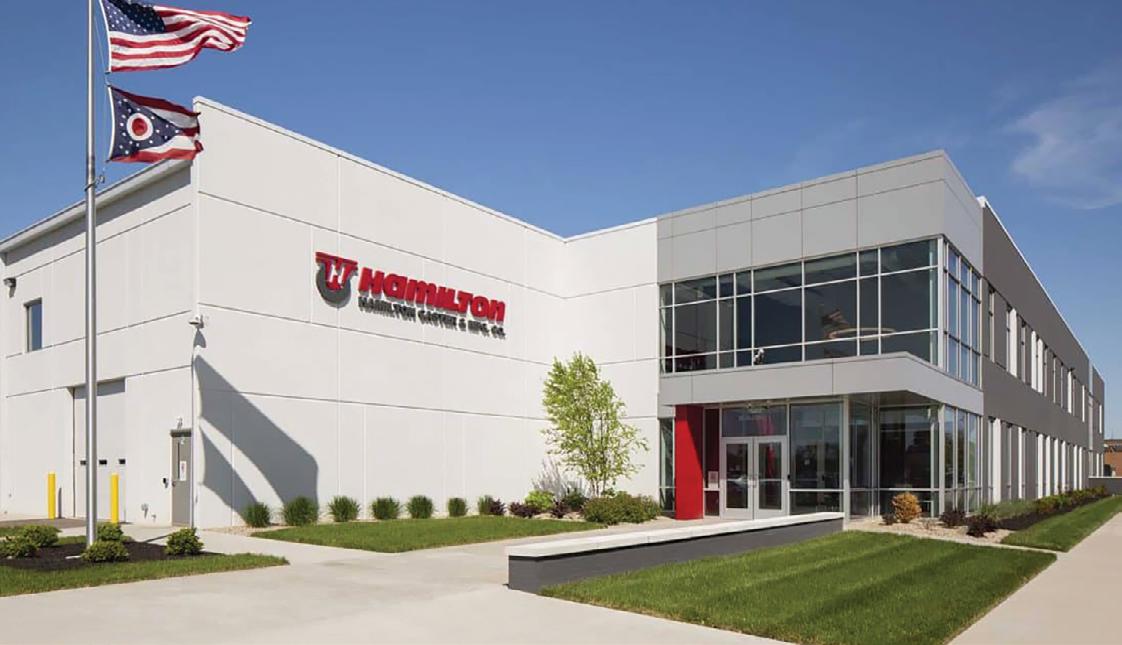
↓
HAMILTON CASTER
↑ LAMBIKIN'S HIDEAWAY
leaves your business doing cartwheels because they are so happy. Stay away from cheap rent, cheap ingredients, and cheap team members as these three things will put you out of business the fastest.
Dave: Devotion to the business and lots of hard work. I recommend any type of business, at any age, should get an advisory board of three or four people. Finding the right people, with the right expertise, can make or break a new business starting up. And utilize the Hamilton Chamber of Commerce to network in our community.
Mindy: It's very important to pivot when you have failures, and be very open to change the way you operate when you need to. Staying fluid helps with the anxiety of trying to do it all.
Ness: I would say that you really need to care more about serving the city than making money when you are starting out. We didn’t go into creating a small business to get rich, we went into it to give the city something they needed. And I think the people who live here responded to that.
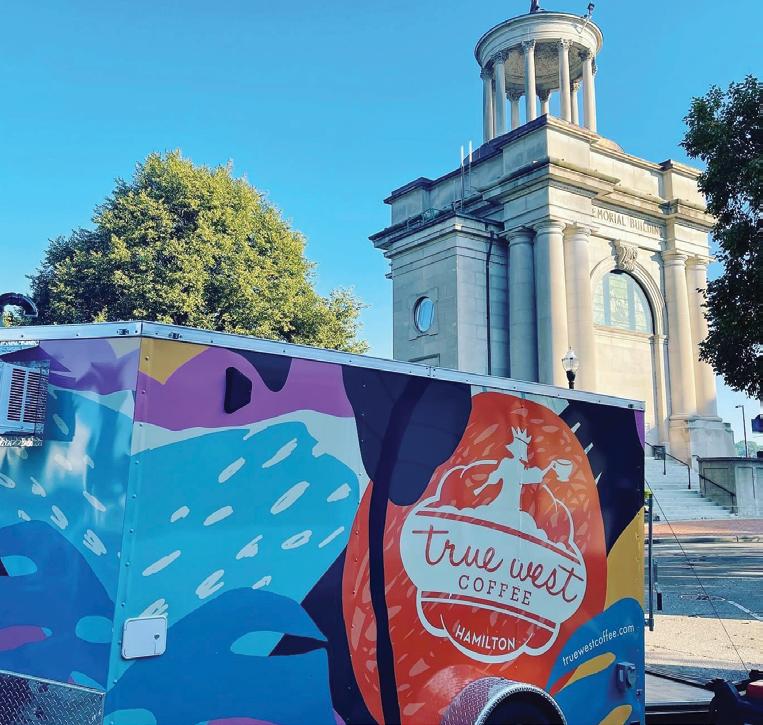
What’s next for your business?
Karen and Steve: A continued intense focus on high quality products served by caring, engaged team members in a clean, inviting environment.
Expansion of our Main Street location
is in the works!
Dave: A transition of leadership to the next generation. My brother and I are retiring and currently working on the succession plan for the next group. Thirteen out of our 102 employees are over 65. Fifteen of our 102 employees have only been here for one year or less. We’re now developing a training program to help lead and take more responsibility.
Nora: We are restarting classes!
Beginner classes for knitting and crochet, also project classes to make hats, scarves, etc.
Mindy: Expansion! The Farmer's Collective will be our next big adventure, it will be a cafe and market featuring local producers.
Ness: We would like to offer more baked goods and desserts, so we are thinking about expanding our dessert offerings. We already make everything from scratch in the house, those cookies are just an example of our potential! We are also catering a lot of events through our new True West on wheels trailer! So, we are booking those events actively right now! Birthday parties, weddings, showers and big block parties are all great options for True West!

WHETHER YOU HAVE BEEN in the market to buy or rent a home, people across the nation and income brackets are struggling to find affordable housing. There isn’t a simple or quick fix to solve the housing crisis but with the combined efforts of a comprehensive plan, “Plan Hamilton,” and organizations like Neighborhood Housing Services of Hamilton (NHS), making housing more accessible to the residents of Hamilton is possible.
To solve this problem, first we need to understand the cause. The rising cost of materials, supply chain issues, and labor shortages due to COVID have impacted housing inventory. We can’t blame the
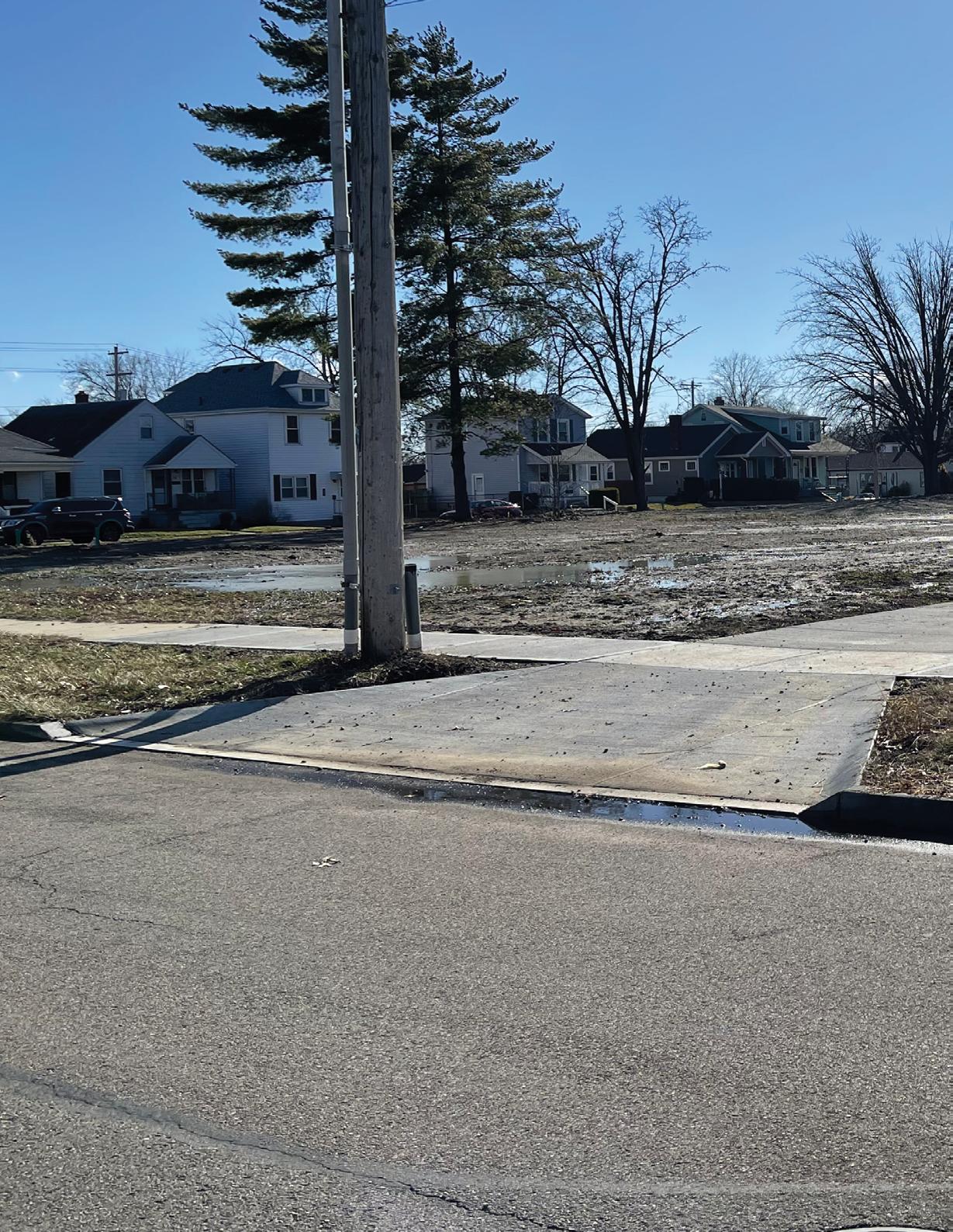
shortage entirely on COVID, the problem existed before COVID then those problems were exacerbated by the pandemic. Essentially, the United States has failed to keep up with the housing demands as the population continues to increase. To make matters worse, institutional investors continue to buy a large portion of inventory for profit. The National Association of Realtors (NAR) estimated these investors accounted for nearly 13 percent of residential real estate purchases in 2021.
How are organizations within Hamilton working to solve this problem? Neighborhood Housing Services of Hamilton has been working on providing
safe, affordable, quality housing to Butler County residents for decades and therefore it is no surprise that they are an important part of the solution to the current housing challenges. The NHS is a blended partnership of residents, government, and community leaders that seeks to build healthier, stronger communities throughout Butler County. NHS’ current projects consist of developing one of the two vacant lots where Lincoln Elementary used to be. The organization is currently building 8 single family homes that will be sold to owner-occupants. NHS designed these homes with the surrounding community character in
mind—the house design, materials used, and alley-accessed garages are consistent with the design of the surrounding blocks. NHS has income guidelines they follow when selling homes which creates affordable homeownership opportunities.
The City of Hamilton is looking for additional partners to further Plan Hamilton’s housing objectives. Liz Hayden, Director of Planning, explained, “The goal is to continue to see a variety of new housing opportunities built. For example, the City of Hamilton is actively looking for people interested in building homes on some of our city-owned lots.” Over the past 10 years, the City of Hamilton partnered with the
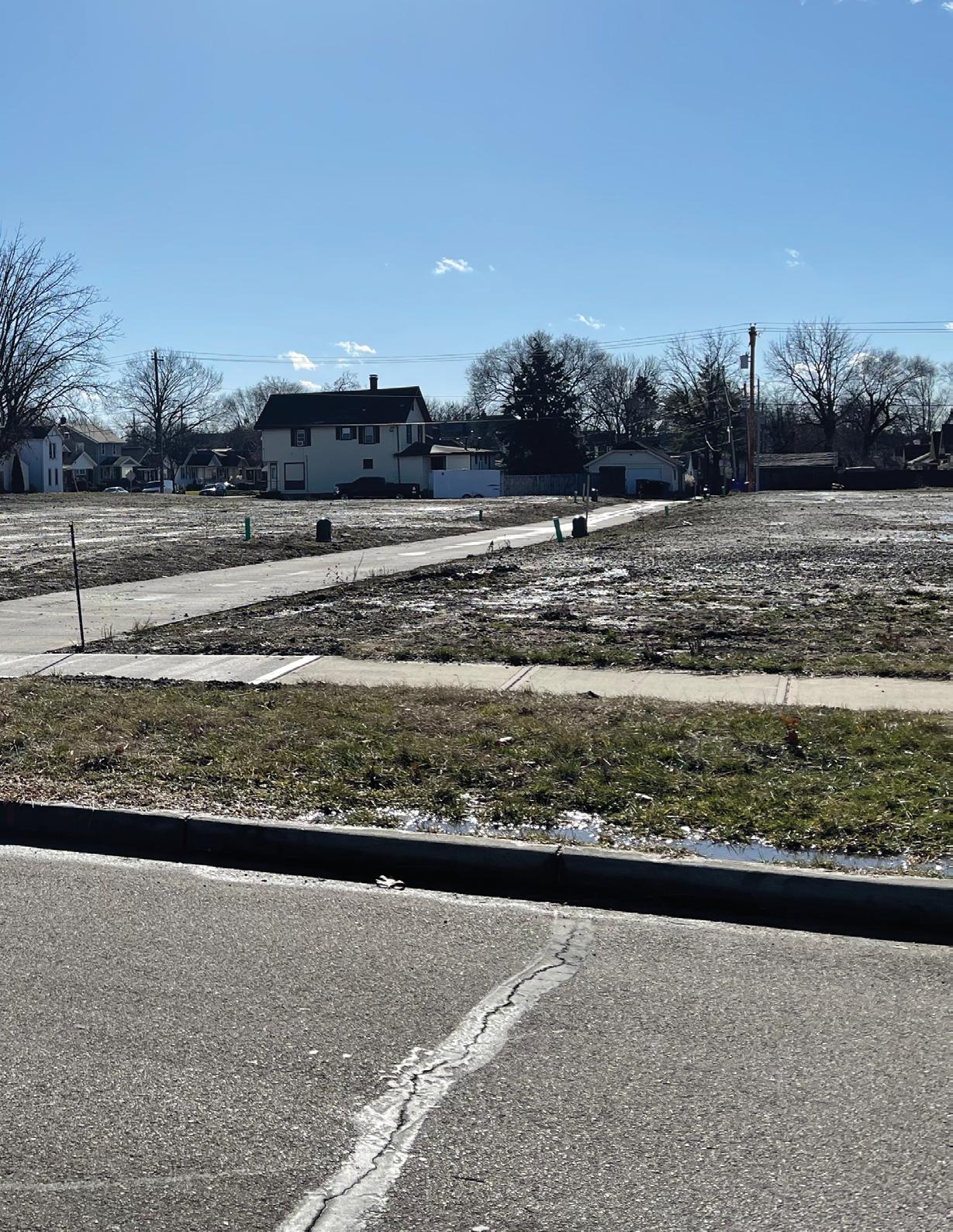
Butler County Land Bank to demolish vacant and blighted homes. Now, the City of Hamilton is looking for people to build new homes on some of these lots with a preference for homeownership. The first two houses that will be built on city-owned lots will be constructed by Neighborhood Housing Services. Hayden gave her thoughts on Hamilton’s future and current housing trends. “I think there is a demand to live in Hamilton’s traditional neighborhoods and new housing on vacant lots can help achieve many of our Plan Hamilton goals—increasing home ownership, promoting the creation of high-quality residential units, and promoting infill development.”
I have always been told that the direction of the housing market is hard to predict but with the efforts of local organizations and private developers, it seems that the housing market in Hamilton is designed with the community and residents in mind. The goals established by Plan Hamilton are focused on increasing available housing opportunities without sacrificing the community and culture that we love. For more details about what is on the horizon with Plan Hamilton, you can visit www.planhamilton.com For more information about Neighborhood Housing Services of Hamilton, visit www.butlercounty-nhs.org.
Rethinking ways to increase home ownership and promote the creation of quality residential units.THE FORMER SITE OF LINCOLN ELEMENTARY SCHOOL


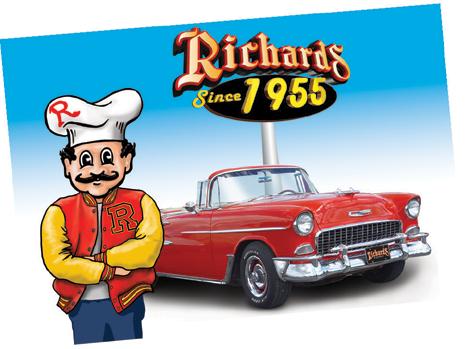

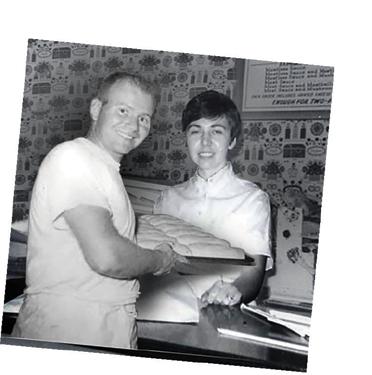

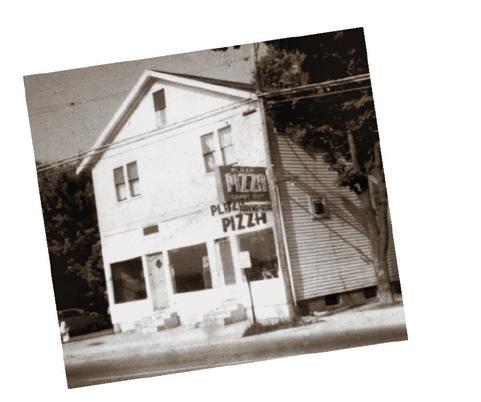

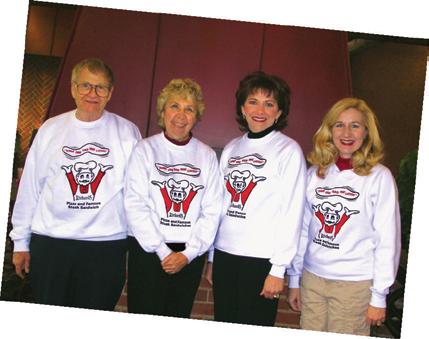

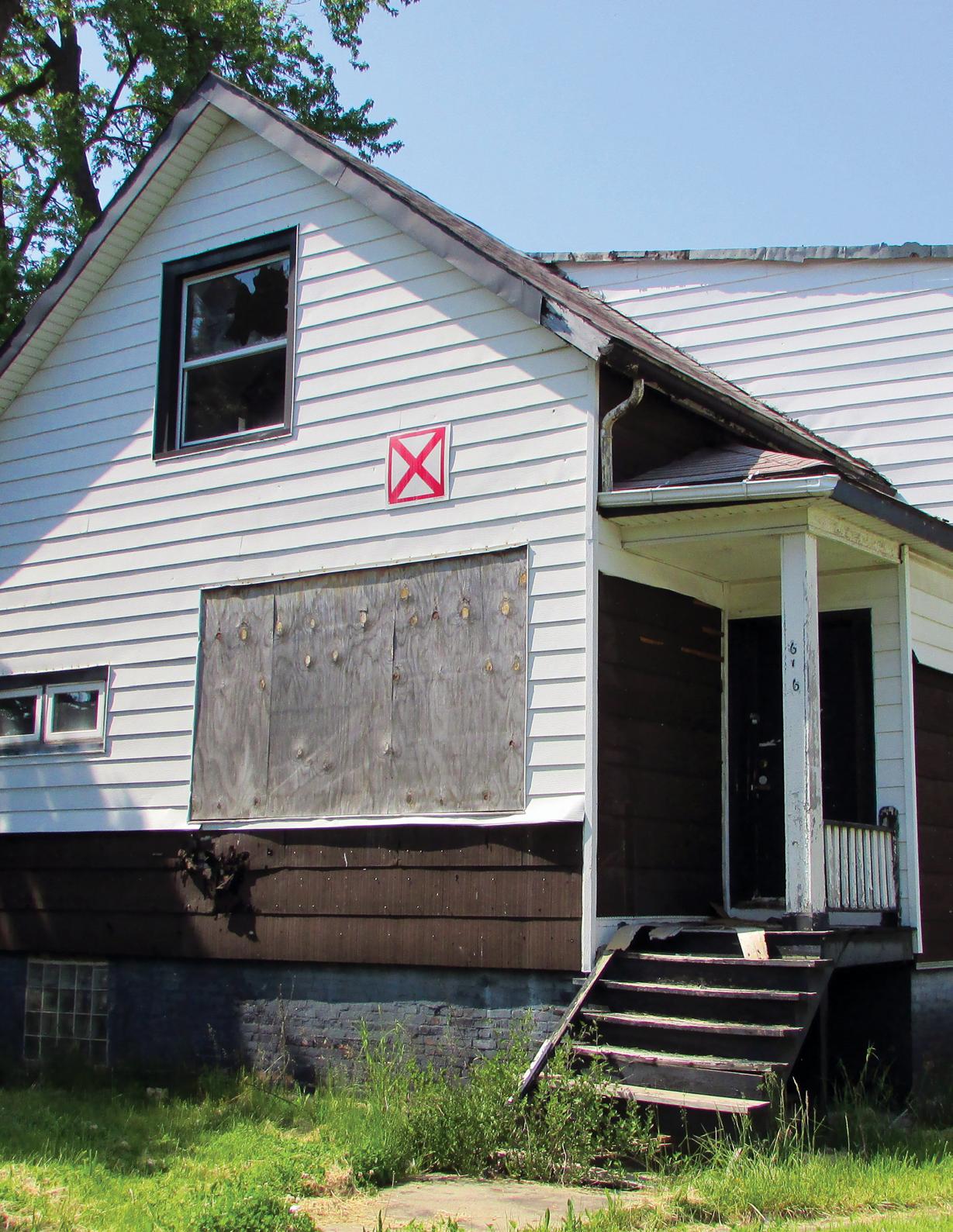
OVER THE PAST few years, the city has rolled out new efforts to help curb blight in our community. One of these programs requires that vacant commercial properties be registered because chronic and long-term vacant properties have a negative impact on neighborhoods. They often have maintenance issues, and occasionally attract vagrancy, illicit activities, and structure fires. A requirement to register these properties gives the city
reliable contact information for the property owner and, in many cases, helps start a conversation about what reactivation of their property could look like. Additionally, in 2021, the City of Hamilton completed a comprehensive property inventory. Seasonal staff teamed with consultants from the Western Reserve Land Conservancy and evaluated every property in the city on a grading scale of A–F. With neighborhoods as a
strategic priority, this data allows the city to better understand the unique challenges within our neighborhoods so that we can make informed, strategic decisions on future programs to improve our housing stock. The city is already making progress using this data. In just the first year, over 60 percent of the D and F properties have been improved or removed. The City has a goal to address all of the worst properties—those graded D or F—by the end of 2024.

CHIP s , the Citywide Hamilton Internship Program, is a 12-week paid internship program for people of color, ages 16-30 in the Hamilton area. Participants have the opportunity to work with local employers who provide handson experience, the chance to develop industry-specific skills, and pathways to leadership success

within the community. CHIPS has already been a life-changing experience for participants of the program. In the last two years, the CHIPS program has won the OEDA (Ohio Economic Development Association) for Excellence in Workforce Development. There are many success stories from individuals who have completed
the program. CHIPs now boasts over 25 community partners, spanning the public, private, and non-profit sectors. Thanks to strong community partnerships and collaboration, the program continues with two cohorts annually in a variety of industry positions. You can learn more about CHIPs at chipshamilton.com.
THE CITY OF HAMILTON and the 17Strong Advisory Board named Andy Weltzer as the 2023 recipient of the Kathleen Klink Award for Neighborhood Leadership. The award was announced and presented during the 17Strong Celebration Breakfast on January 21 at the Hamilton High School—Freshman Campus.

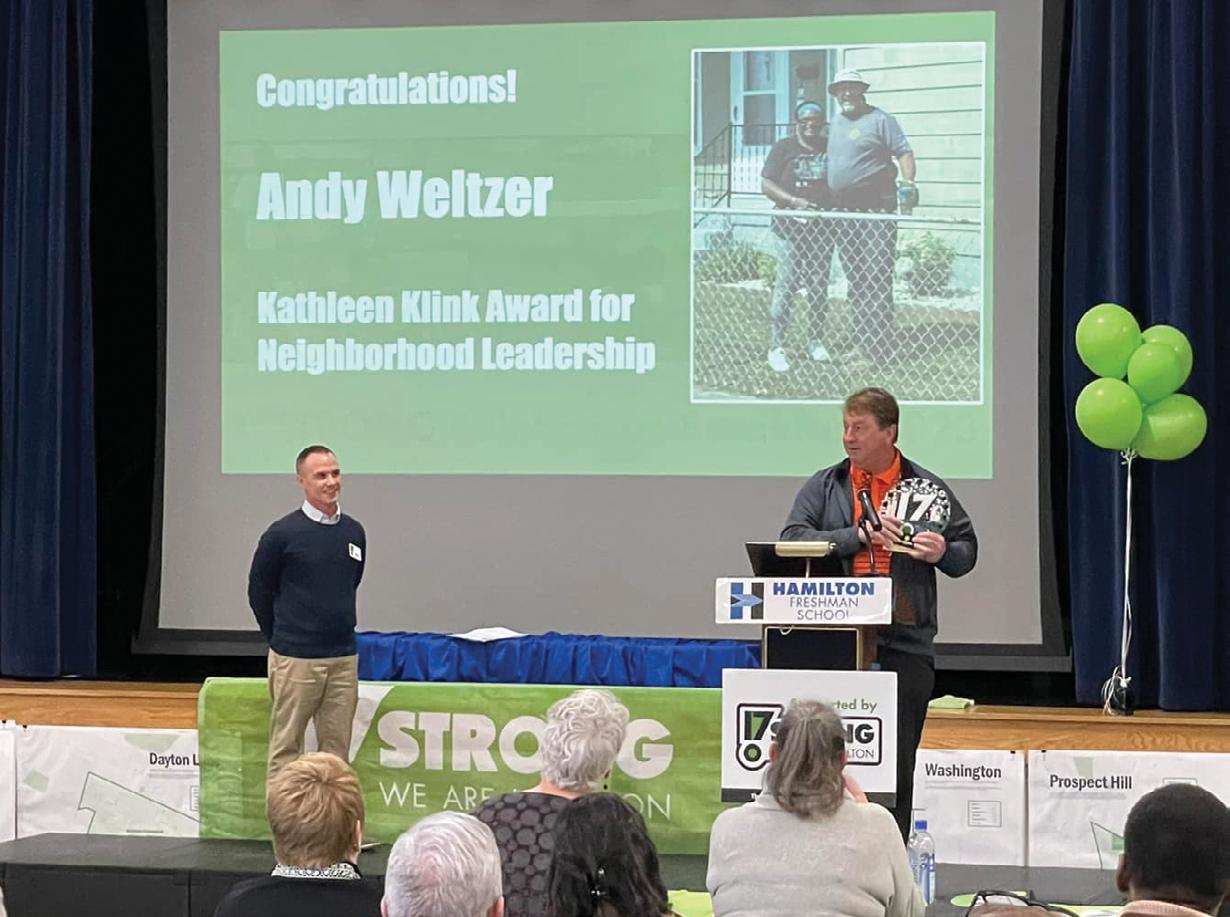
This award is named in honor of Kathleen Klink, a long-time public servant who has been the quintessential neighborhoods council person. She was also a key lead on council that crafted the city's 2012 strategic plan. The award is given annually to a Hamilton resident who works relentlessly in pursuit of building safe, clean, and engaged neighborhoods.
Before the award presentation, Kyle Cummins, new chair of the 17Strong Advisory Board and Washington neighborhood resident, referenced sentiments and words from the community members who nominated Weltzer.
“Andy is a dedicated, very
hardworking individual who has shown interest and devotion to the City of Hamilton through his work of beautifying many properties throughout the city. He has continually contributed to the growth and excellence of this city. When I see him, I see a relentless man. I have never seen a man work so physically hard at his own job, and then come home only to go back out with a trash bag, walk the entire neighborhood, and pick up other people's discarded trash.”
As full-time business owner of Lifestyle Landscape Solutions LLC, Weltzer certainly keeps a busy schedule. But it's evident that his nine-to-five does not prevent him from volunteering his time and resources to local
organizations like Consortium for Ongoing Reinvestment Efforts (CORE) and Hamilton Parks Conservancy.
Kyle went on to exclaim that Weltzer has been a sponsor of Love Your Block since it began, an initiative that has greatly benefitted from the time and resources provided by volunteers like him. But the neighborhood that has been impacted most by his dedication is German Village, where he resides.

“As the current German Village Association president, he is an effective communicator and brings great integrity to the position, inspiring residents toward a common purpose of pride and unity. He facilitates open communication between community members and local police officers, lending
an assured sense of safety to our neighborhood watch program. He has been known to say 'Hamilton is not where I grew up, but it is most definitely my home.'”
Weltzer also represents the German Village Historic District through his service to the Architectural Design Review Board (ADRB). As a board member, he helps the ADRB to review plans for work on historic structures and properties, monitor the work, and administer the Architectural Conservation/Historic District section of the Hamilton City Zoning Ordinance. Weltzer’s walk to the podium to accept his award was accompanied by enthusiastic applause, but when he reached the microphone, he made it clear that the honor did not only belong to him.
"[This is] an award that, quite frankly, everyone in this room deserves a piece of. Everyone here deserves this more than I deserve this,” Weltzer stated.
"It's a great city, and I'm choked up
right now because this is not what I do this for. And everybody who works with me knows that.”
He continued, “As I watch this organization get bigger and get more people involved, I'm proud to be a part of that.”
Weltzer ended his acceptance speech by proposing a goal not only for himself, but for other members in the Hamilton community.
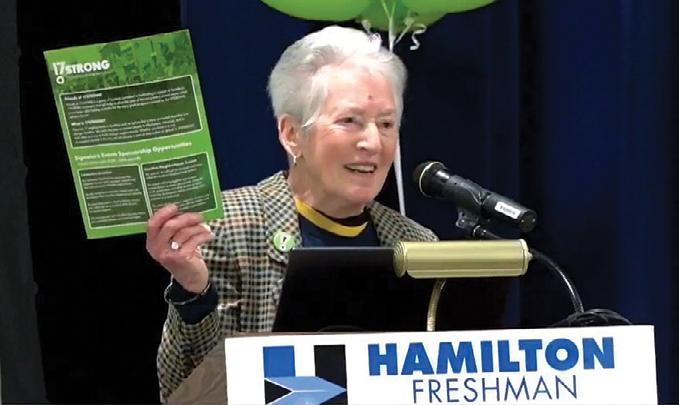
“I will say one thing that I'm going to work on for this year, it being a recurring theme in my talks in German Village, is challenge. Challenge your neighbors, challenge your friends, to do just a little bit more in your neighborhoods. Whether that's waving to someone from your porch, saying 'Hi,’ picking up a random piece of trash. Showing up at somebody's doorstep, being involved in the activities in town. Challenge everybody to do just a little more. Get a little bit more involved and get people in your neighborhood more involved. Thank you so much."

IN THE STATE of Ohio, Hamilton is the only city that fully operates all four major utilities thanks to a long history of community leaders advocating for these services. Through our community owned utilities, the City can invest for its future while simultaneously taking care of the needs of the citizens. From the world’s best-tasting water, to our reliable electricity grid and everything in between, Hamilton is in a league of its own with utilities.
“It’s not just the fact your lights turn on,” said Bill Hudson, Hamilton’s Director of Utility Operations. “It’s our
team's work that takes power from our power plants to the grid, and from the grid to your homes.”
It’s every step along the way, and Hamilton has it covered.
“We have more than 200 people who work to make sure that our infrastructure is running how it should be running,” said Hudson. “And they’re only focused on our 22 square mile footprint.”
Even further, it doesn’t just benefit the homes of citizens, it benefits the companies that choose to set up shop here.
“There are companies here in
Hamilton that wouldn’t be in Hamilton if it wasn't for our utilities,” said Hudson. “And one reason for that is our stable rates and reliability across the board.”
Over a century ago Hamilton invested in its future when it first created the foundation for our utilities. It’s doing the same now, with its hydroelectric plants along the Ohio River.
“We are a majority partner alongside 47 other communities in the Meldahl and Greenup hydroelectric plants,” said Hudson. “Hydro offers a lot of production
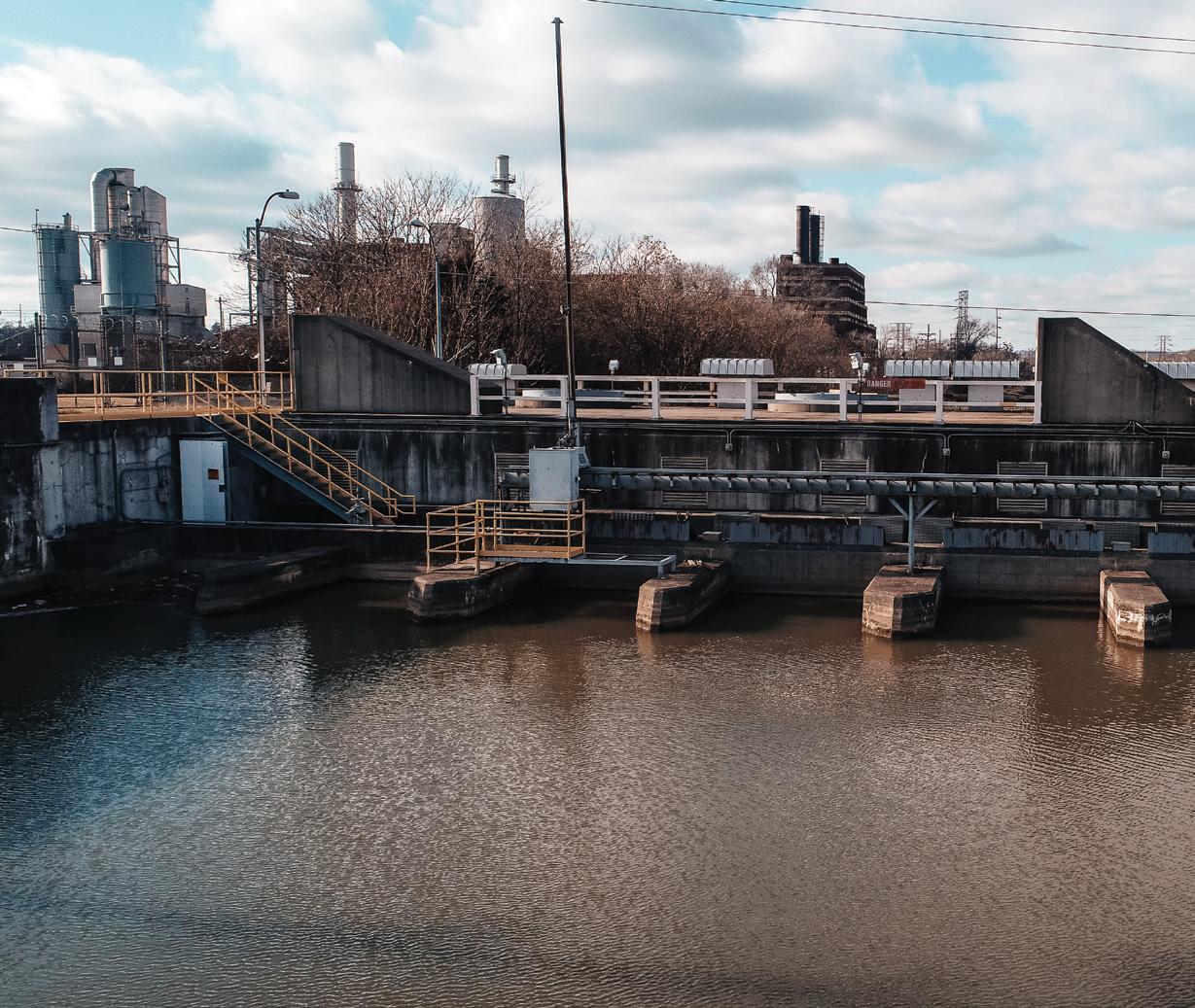
Hamilton is a city that is totally self-propelled.
price stability. As public institutions, we aren’t going anywhere and hydro offers one of the best long term returns. Our energy rates will be much more stable now because all we have to do is maintain the facility. After all, the water is free.”
It’s not just the hydro power that benefits Hamilton residents and businesses alike. It’s how reliable our utilities have become. The Department of Infrastructure constantly stresses its ability to be reliable. It’s for these efforts that Hamilton was recognized by the American Public Power Association, as they were awarded the
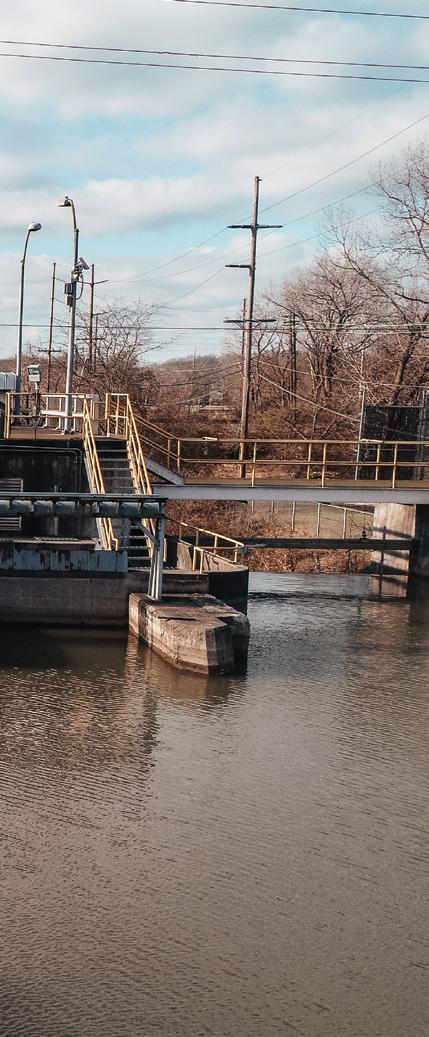
E.F. Scattergood System Achievement Award in 2022.
“We’re very reliable because we proactively invest in our infrastructure,” said Hudson. “We are trimming trees around power lines, putting linings in our sanity sewer, and updating our transmission equipment.”

Having reliable utilities is a humongous deal for residents, sure. But for industries, it’s even more so. For certain companies in Hamilton, if they lose power for just a second, it could take two hours to restart production, simply because a disruption could compound problems.

“We understand that reliable service is critical for our customers, we put the work in, we have seen the results, and for our efforts we have won a number of awards,” said Hudson. “That is something we can tout when someone is looking to
open a business in Hamilton. We can’t promise the power will be on tomorrow, but generally speaking, the power is on 99.99 percent of the time for our customers.”
As the lone city in the buckeye state that provides all four major utilities to its citizens, Hamilton doesn’t rest on that fact. The City is constantly investing in the future, recognizing that the quality and reliability of the City’s infrastructure will benefit citizens and businesses for decades to come.

• One of the lowest tuition rates among Ohio four-year universities.



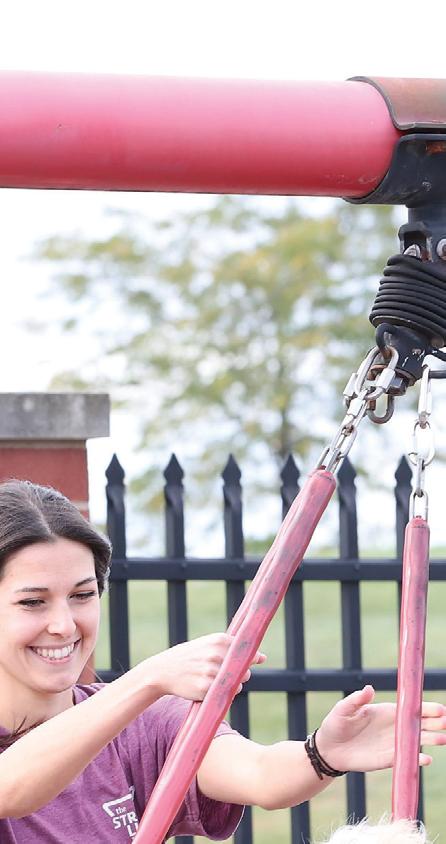
• Associate and bachelor's degrees options with over 30 majors, several available 100% online, plus an online Master’s in Nursing degree.
• WORK+ program allows you to work part-time while earning your degree; companies pay an hourly wage and cover your tuition.

• Resources and student support network for first-generation students; adult learners; transfer students; veterans, active military, and military-affiliated.









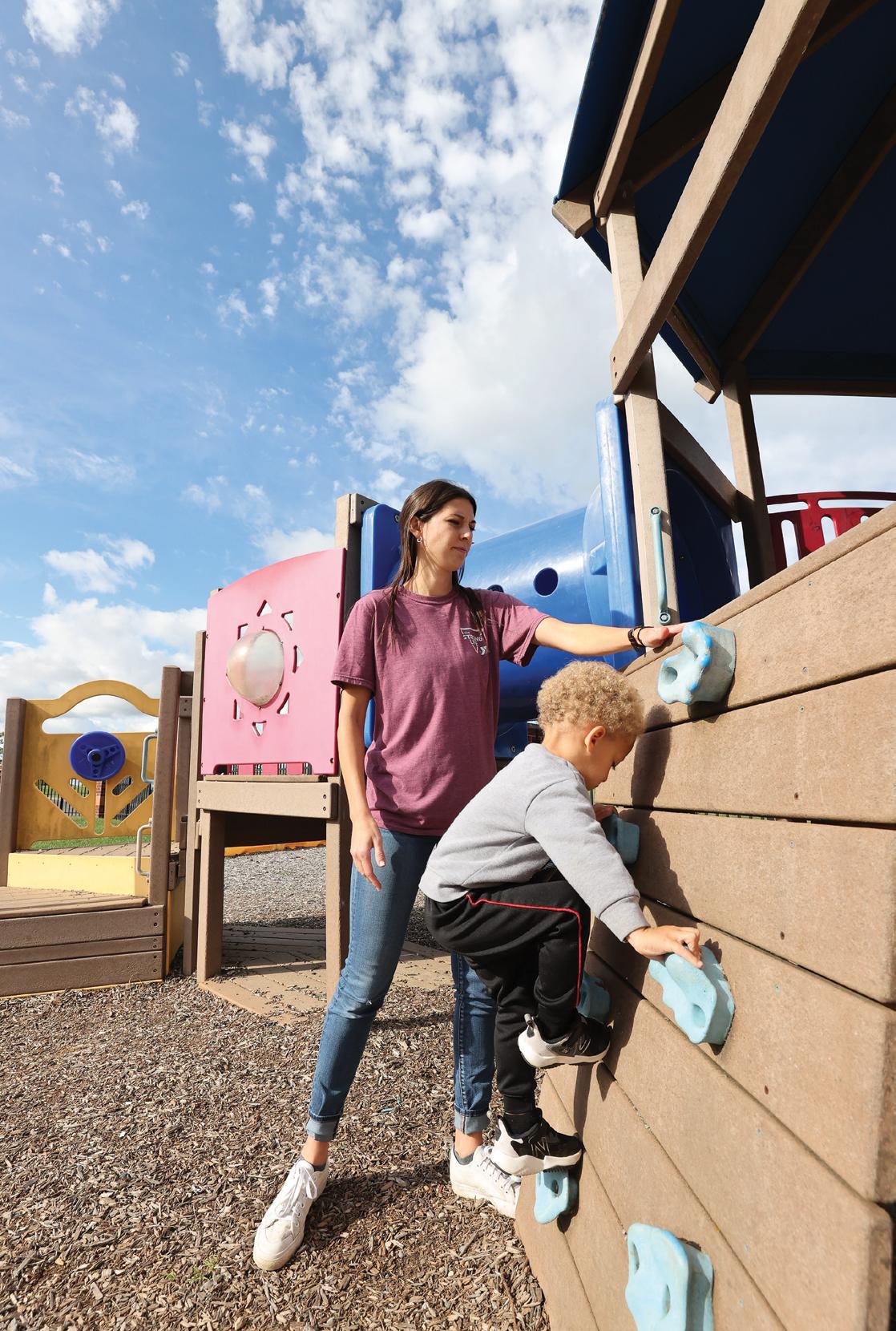
Call



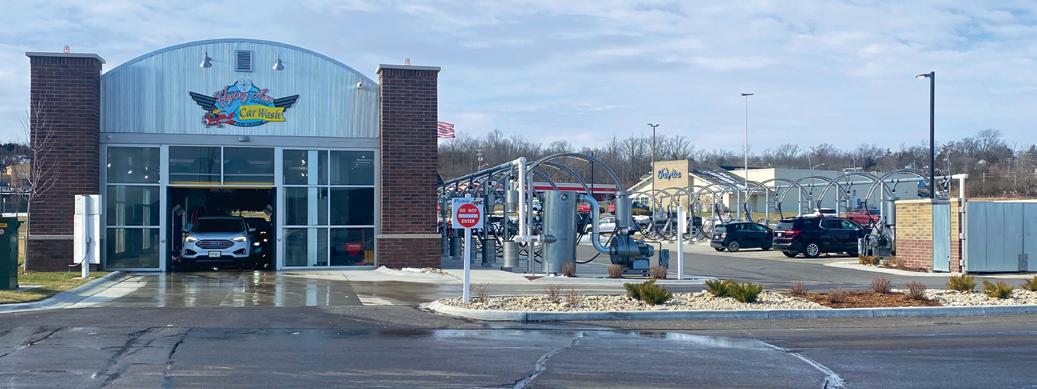
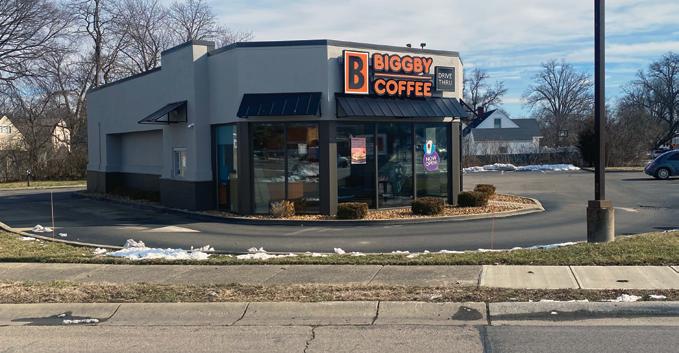
RESTAURANT, RETAIL, and recreational amenities are expanding rapidly on Hamilton’s west side. Panda Express, a second Biggby Coffee, and Flying Ace Car Wash are among the most recent developments along Main Street. The former Danberry Theater is ready for redevelopment with new plans for the space being developed, which include the buildout of a Shooters Sports Grill. Interest from restaurants and service providers continues to grow and many more such developments are anticipated in coming years.

THROUGH PURPOSEFUL planning and effective enforcement, the City of Hamilton’s Planning Department works to support and encourage strong and safe neighborhoods.

Hamilton’s Planning Department has successfully been improving our outdated zoning and making strides on how to utilize our City’s riverfront while enhancing our neighborhoods. It’s been a gradual transformation as the team rezones certain districts that haven’t been changed since the 1920’s. Liz Hayden, director of planning, said they have rezoned an estimated 20 percent in the past five years. Hayden continued with, “Zoning has a quiet effect in our neighborhoods. If zoning is working, you won’t notice it…Our zoning should reflect our vision for our community and where we’re going.”

Some of the most impactful zoning changes have been in our neighborhoods. Prospect Hill, Dayton Lane, Lindenwald and Rossville to name a few. These neighborhoods were originally zoned as a general multi-family residential neighborhood. But as urban, walkable neighborhoods with a mixture of uses, they were rezoned to the new traditional zoning which better reflects the original fabric
of these neighborhoods. “Hamilton’s older neighborhoods traditionally have a broader mix of housing types and nonresidential uses, as well as higher densities than the suburban neighborhoods. Lots of traditional neighborhoods are typically located along streets that make up a grid system, or a modified grid system, with a high level of connectivity within the neighborhood and to adjacent business areas. It is a goal of this plan to encourage the protection of these traditional neighborhoods including
the wider array of uses located within them. The primary land use in traditional neighborhoods is, and should continue to be, single-family detached homes with a density of five to 10 units per acre,” according to Plan Hamilton’s website. The planning department continues to look at each of our 17 distinct neighborhoods to create better boundaries and set the tone for the future.
The Ohio Department of Health writes that “zoning promotes public health and safety, manages density, encourages a variety of housing, and attracts businesses and industries,” which is exactly what the Planning Department has been committed to doing. One way is by updating documents on their website to provide many answers to questions citizens might have. Their official zoning ordinance is 330 pages long and can easily be found online. It goes a great deal in depth in the hope to “create a standard of development in Hamilton that we can be proud of and that will not fall apart in five to 10 years,” explains Hayden. Having the correct zone or rules in place helps with guiding the day-to-day projects, for example
adding a shed or a fence to your property. The zoning ordinances sets a starting guidance for how and where projects like these are appropriate. “If left to their own devices, sometimes people will build their own version of a shed, when it’s really not. I always say, when people live close to each other you have to have rules about what you can and can’t do on your property because those decisions unfortunately affect a lot of other people around you,” said Hayden. The lengthy zoning ordinance is extremely detailed, and is a great resource to find the correct size, design, location, siding material, etc. that would be allowed based on your project and where you live.
Another substantial step toward our City’s future through zoning is the River Master Plan, which was introduced in 2017. The plan focuses on the small area where Hamilton meets the Great Miami River. The main goal is to reconnect people to the river, which included rezoning the riverfront from industrial to entertainment and mixed-use. When
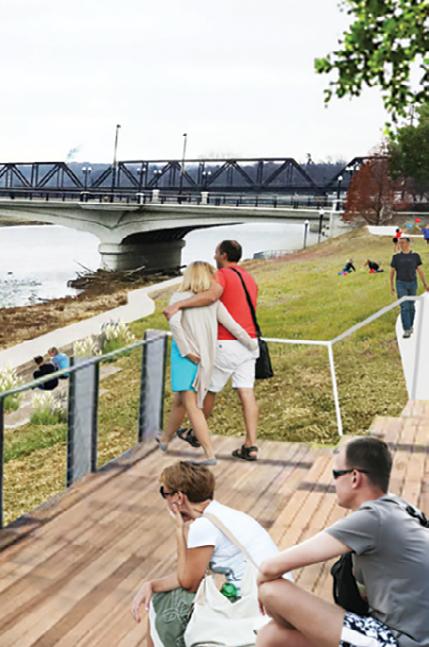
SMART Papers (Champion Coated Paper Co.) closed in 2012, the site was originally zoned as industrial and
many companies tried to take over that spot just to store equipment. But because City officials' vision for our City was larger than a storage unit alongside the river, they rezoned and waited to find the right fit. Fast forward to this year, Spooky Nook Sports Champion Mill, the nation’s largest sports complex including a hotel and conference center is now open. It spans over 1,000,000 square feet and is expected to bring people
from all over the United States to visit our town.
All of these zoning improvements are impactful to our City and the quality of our neighborhoods. These small changes, in the long run, will create a better “quality of life and livability in Hamilton” as quoted from the Plan Hamilton website. “It doesn’t hurt my feelings if people don't think about zoning, that means we’re doing it right,” says Hayden.

SEE A POTHOLE, a street light, or a property that needs attention?
MyHamilton (311) makes it easy to report issues spotted throughout the community. This app is available at the City’s website and for iOS and Android devices.




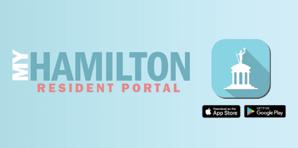

BLOOMFIELD/SCHON, in partnership with the City of Hamilton, is embarking on a transformative journey with the redevelopment of the Shuler-Benninghofen Mill on the corner of Pleasant and Williams Avenues. This $20+ million investment is set to be a game-changer for the Lindenwald business district, bringing over 100 new apartment units and dynamic retail space to a long-neglected historic property in Hamilton’s most populous neighborhood.
The developers will be submitting their historic tax credit application in the Spring of 2023, with construction set to commence in the Spring/Summer of 2024. This is an opportunity to breathe new life into a historic property and bring economic growth to the area.

In addition, the iconic Roemer Hardware building, located at the same intersection, is also getting a facelift. A $600,000 renovation of the first-floor commercial spaces is underway, and recruitment for an anchor tenant is set to begin soon. This is an exciting time for the Lindenwald community as we watch the lights come back on at this long vacant building, bringing a renewed sense of vitality to the area.

Several proposed projects in 2024 are expected to be a significant economic area game changer.ROEMER HARDWARE SHULER & BENNINGHOFEN CO
HAMILTON ’ S DOWNTOWN has undergone a tremendous transformation over the past 12 years, with rehabilitated buildings, new housing options, and a thriving small business community. In the past year, three new designated districts were added to the expanded downtown area:
1. The Maple Avenue Corridor, also known as The MAC, which features the historic Train Depot and a new brewery.


2. The North End Corridor, where the new Stone Tavern is opening.
3. Champion Canyon, home to the largest indoor sports complex in the United States, with even more redevelopment to come.
The next five years promise to be even more exciting as businesses look to recover from the pandemic and capitalize on the opening of Spooky Nook Sports Champion Mill.
48 Plan Hamilton
